Japanese interior design represents a harmonious blend of minimalism, natural beauty, and mindful living that has captivated designers worldwide. Rooted in ancient philosophies like wabi-sabi and zen Buddhism, this aesthetic approach emphasizes simplicity, functionality, and deep connection with nature. Traditional Japanese homes showcase thoughtful design elements that create serene, uncluttered spaces promoting tranquility and meditation. From tatami mats and shoji screens to tokonoma alcoves and engawa verandas, each component serves both practical and spiritual purposes. Modern interpretations of Japanese design continue to influence contemporary interiors globally, offering timeless solutions for creating peaceful, balanced living environments that nurture both body and soul.
1. Japanese Interior Design with Wabi-Sabi Natural Material Integration
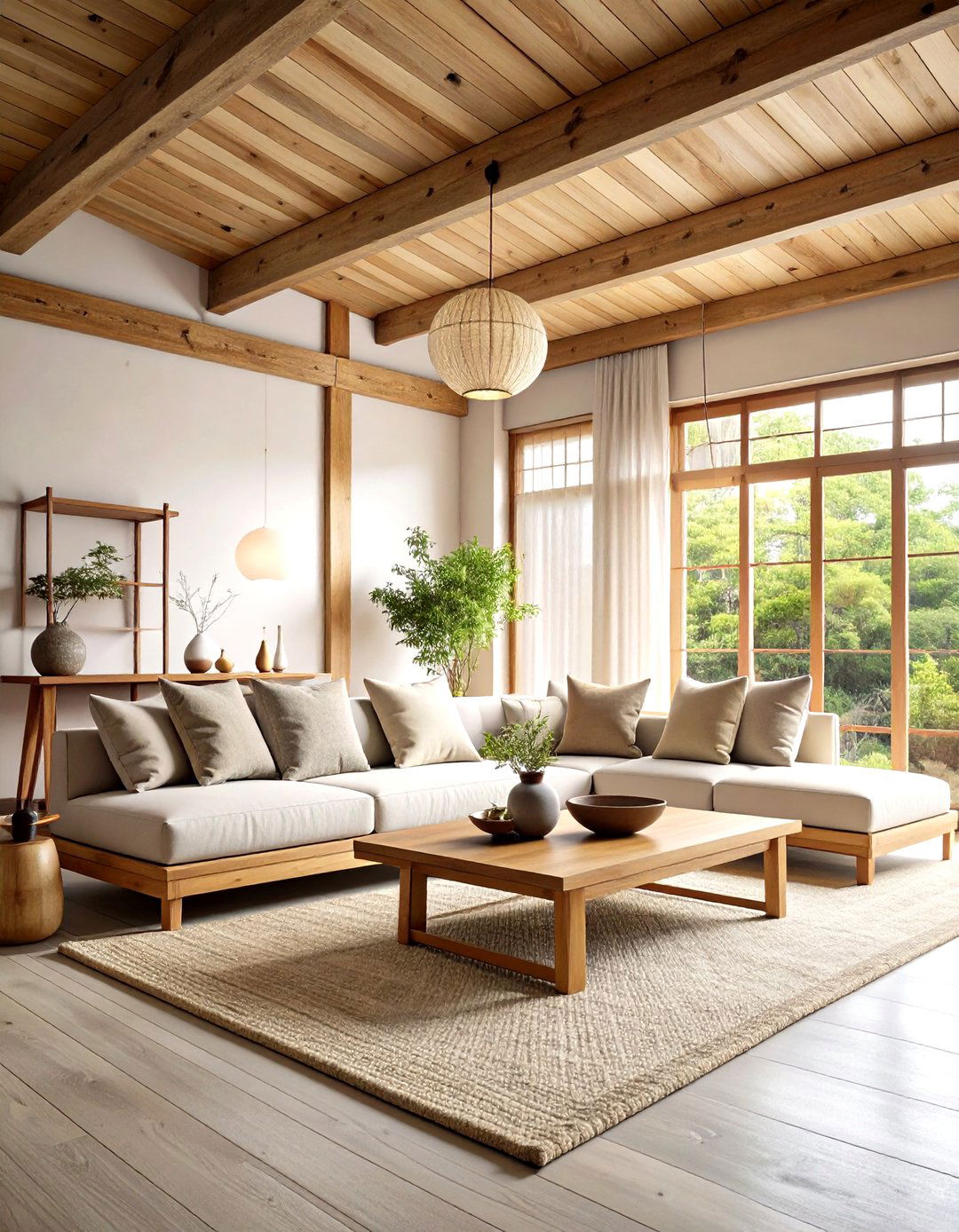
Wabi-sabi Japanese interior design celebrates the beauty of imperfection through natural materials that showcase their inherent flaws and aging process. This philosophy encourages incorporating weathered wood beams, stone surfaces with natural variations, and clay pottery with visible irregularities. The design involves accepting wrinkles in curtains, patina on walls, and cracks in wood paneling. Choose reclaimed wooden furniture pieces that display their history through scratches and wear marks. Select handmade ceramics with uneven glazes and organic textures that tell stories of their creation. Include elements like aged copper fixtures that develop beautiful patina over time, or bamboo accessories that show natural nodes and variations. This approach transforms imperfections into focal points, creating spaces that feel authentic, lived-in, and deeply connected to the natural world's ever-changing beauty.
2. Japanese Interior Design Using Traditional Tatami Mat Flooring
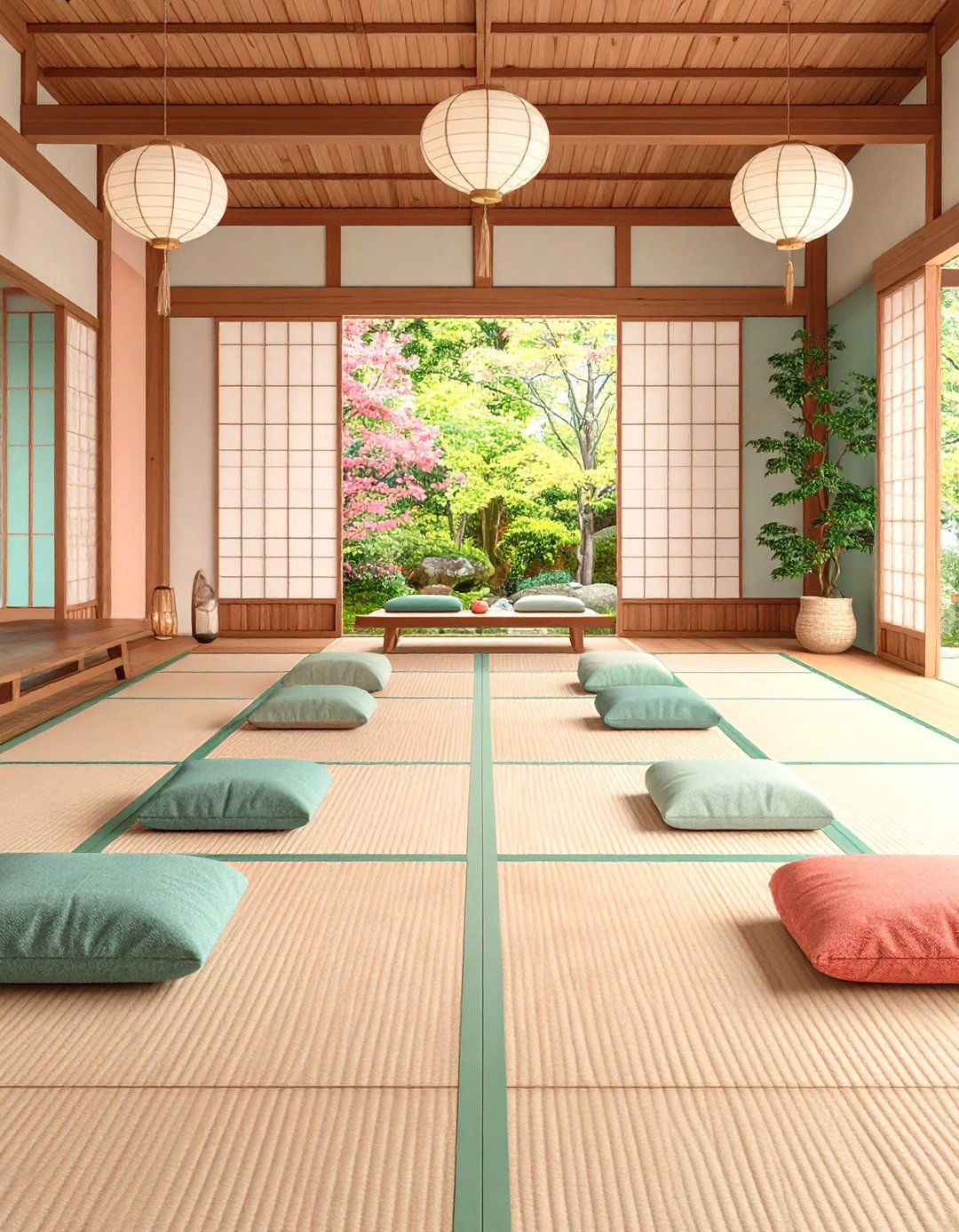
Tatami mats are thick, woven straw mats that measure about one by two meters and have been integral to Japanese homes for centuries. These traditional floor coverings create defined spaces while providing natural insulation and comfort. Tatami reminds the Japanese of "home" and wherever there is tatami, there is "home". Install authentic tatami in dedicated meditation rooms or reading nooks to establish sacred spaces for contemplation. The natural rush grass surface offers a pleasant texture underfoot and releases a subtle, earthy fragrance that enhances the sensory experience. Room sizes in Japan are commonly measured by the number of mats that would fit, demonstrating their fundamental role in Japanese spatial planning. Combine tatami with low furniture pieces and floor cushions to maintain the traditional aesthetic. Remember that footwear should be removed before stepping onto tatami, honoring the cultural significance and maintaining cleanliness.
3. Japanese Interior Design Featuring Elegant Shoji Screen Room Dividers
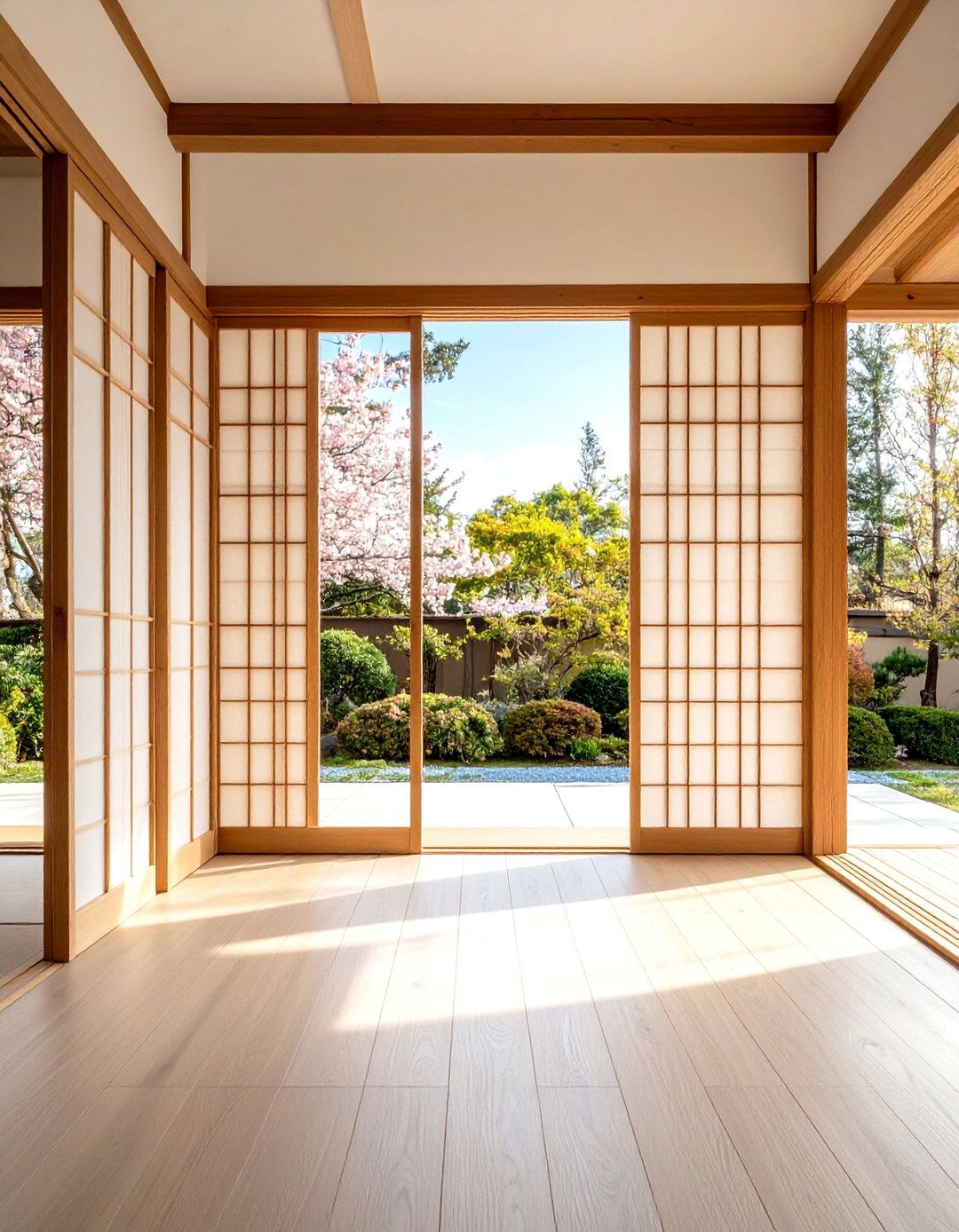
Shoji are doors, windows or room dividers used in traditional Japanese architecture, consisting of translucent sheets on a lattice frame. These versatile panels create flexible living spaces while filtering natural light beautifully throughout your home. Shoji are valued for not setting a sharp barrier between the interior and the exterior, allowing light deep into the interior. Install sliding shoji screens to separate spaces without creating permanent walls, maintaining an open, flowing layout. The rice paper panels diffuse harsh sunlight into soft, ambient illumination that changes throughout the day. Shoji are very lightweight, so they are easily slid aside, or taken off their tracks and stored in a closet. Choose frames made from traditional woods like cedar or hinoki for authenticity. Modern interpretations can incorporate frosted glass instead of paper for increased durability while maintaining the essential light-filtering qualities that make shoji so distinctive.
4. Japanese Interior Design with Sacred Tokonoma Display Alcoves

A tokonoma is a recessed space in a Japanese-style reception room, in which items for artistic appreciation are displayed. This elevated alcove serves as the focal point of traditional Japanese rooms, showcasing seasonal art and meaningful objects. Items shown are chosen carefully based on the season, the occasion, and even the social status of the guest. Create a tokonoma-inspired display area using a simple wooden platform or recessed shelf space. Display a single hanging scroll, ceramic piece, or ikebana arrangement that changes with seasons or special occasions. The philosophy behind tokonoma elevates this alcove into a creative statement that showcases an individual's tastes and refinement. Keep the space uncluttered, following the principle that less is more. Modern interpretations can use floating shelves, mantelpieces, or window sills as tokonoma-style spaces. Focus on quality over quantity, selecting pieces that bring joy and reflect your personal aesthetic journey.
5. Japanese Interior Design Through Mindful Ikebana Floral Arrangements
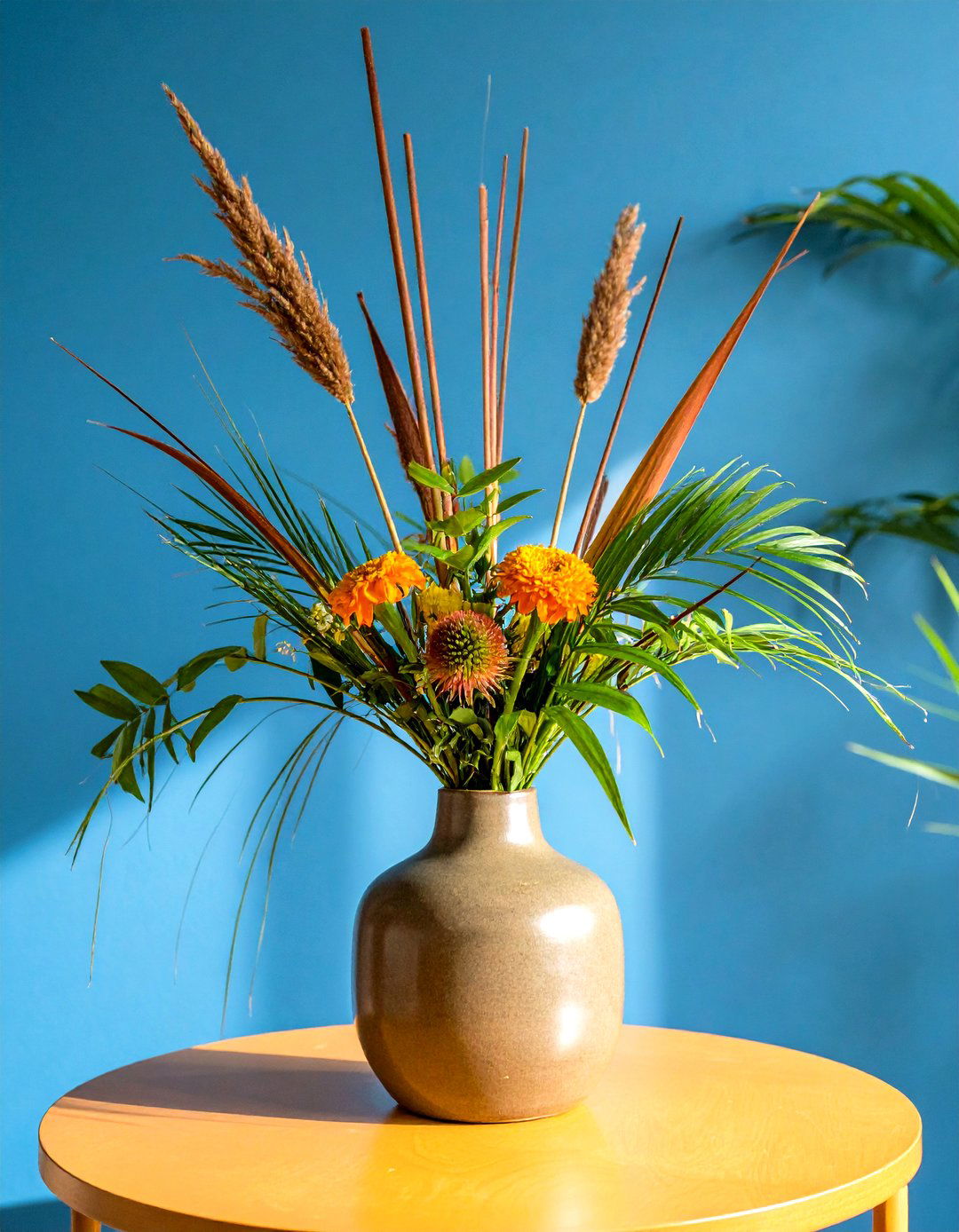
Ikebana, the Japanese art of flower arranging, transforms simple floral arrangements into profound expressions of form and balance, emphasizing minimalism and harmony. This ancient practice brings natural beauty and artistic expression into interior spaces through carefully composed arrangements. Unlike Western bouquets that emphasize abundance, ikebana celebrates negative space, asymmetry, and the relationship between flowers, branches, and container. Practice this art by selecting a few carefully chosen stems and arranging them in ceramic or bamboo vases with clean, simple lines. Focus on the natural curves and angles of each element, considering how they interact within the composition. Change arrangements seasonally to reflect nature's cycles and maintain connection with the natural world. Ikebana developed to the point of being considered an art in its own right and is still found today in tokonomas for the zen atmosphere it gives off. The meditative process of creating ikebana becomes as valuable as the finished arrangement itself.
6. Japanese Interior Design with Comfortable Zabuton Floor Cushion Seating
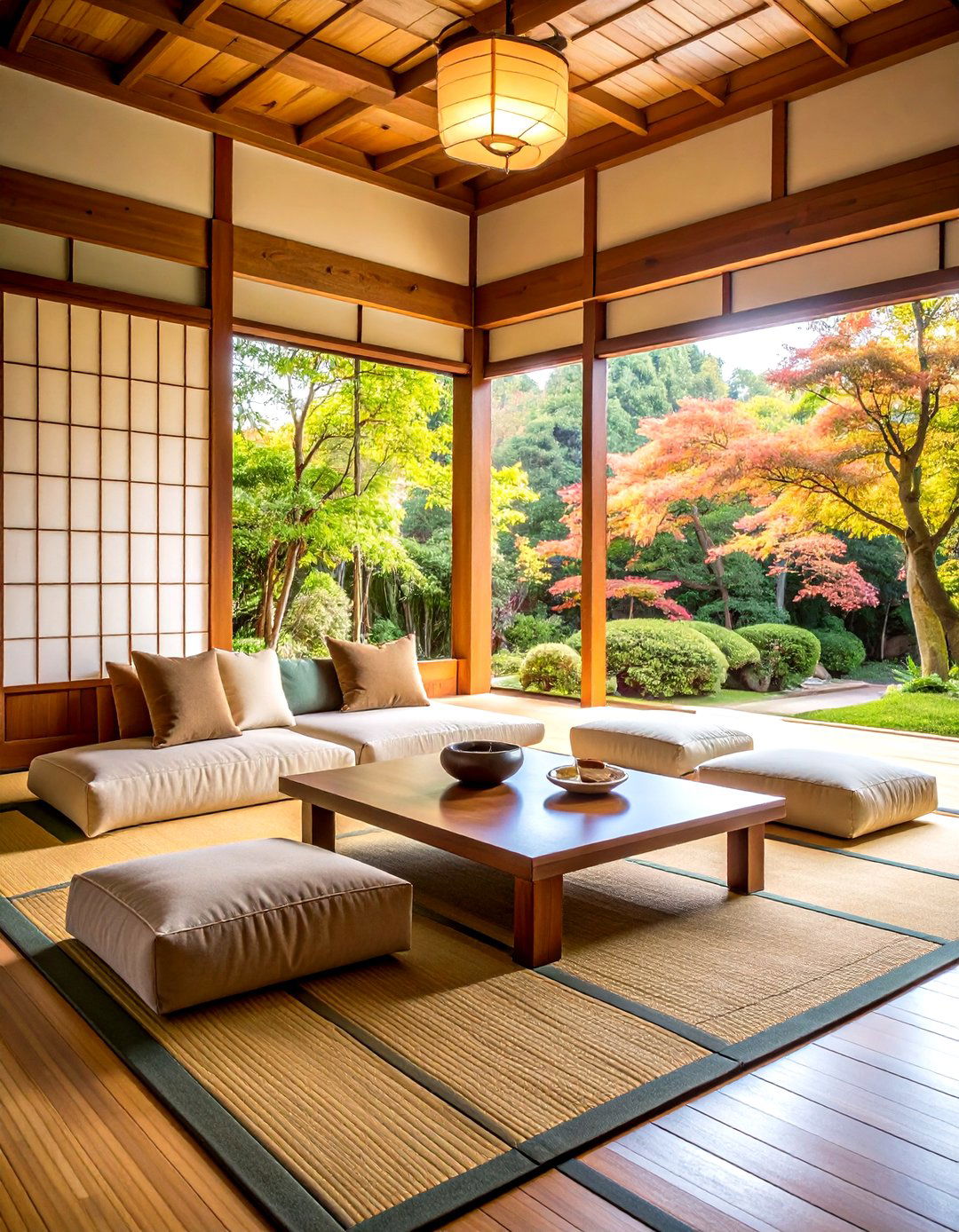
Zabuton are rectangular cushions, sort of like miniature futons, that make sitting or kneeling on the floor for long periods more comfortable. These traditional seating elements encourage a closer connection to the ground and promote relaxed, informal social interactions. Zabuton is a Japanese style cushion used on Tatami-floor, typically measuring 55cm by 59cm with some thickness. Incorporate zabuton cushions around low coffee tables or in meditation areas to create comfortable floor seating arrangements. Choose cushions filled with natural materials like buckwheat hulls or cotton batting for optimal support and breathability. Traditional fabrics include cotton, silk, or linen in neutral earth tones that complement the overall Japanese aesthetic. In Japanese custom, when visitors come over to your house, the first thing to do is to provide Zabuton for sitting. Layer multiple cushions to accommodate different comfort preferences and create inviting spaces for tea ceremonies, meditation, or intimate conversations. The low seating perspective changes your relationship with the room and encourages mindfulness.
7. Japanese Interior Design Using Graceful Noren Fabric Entrance Curtains
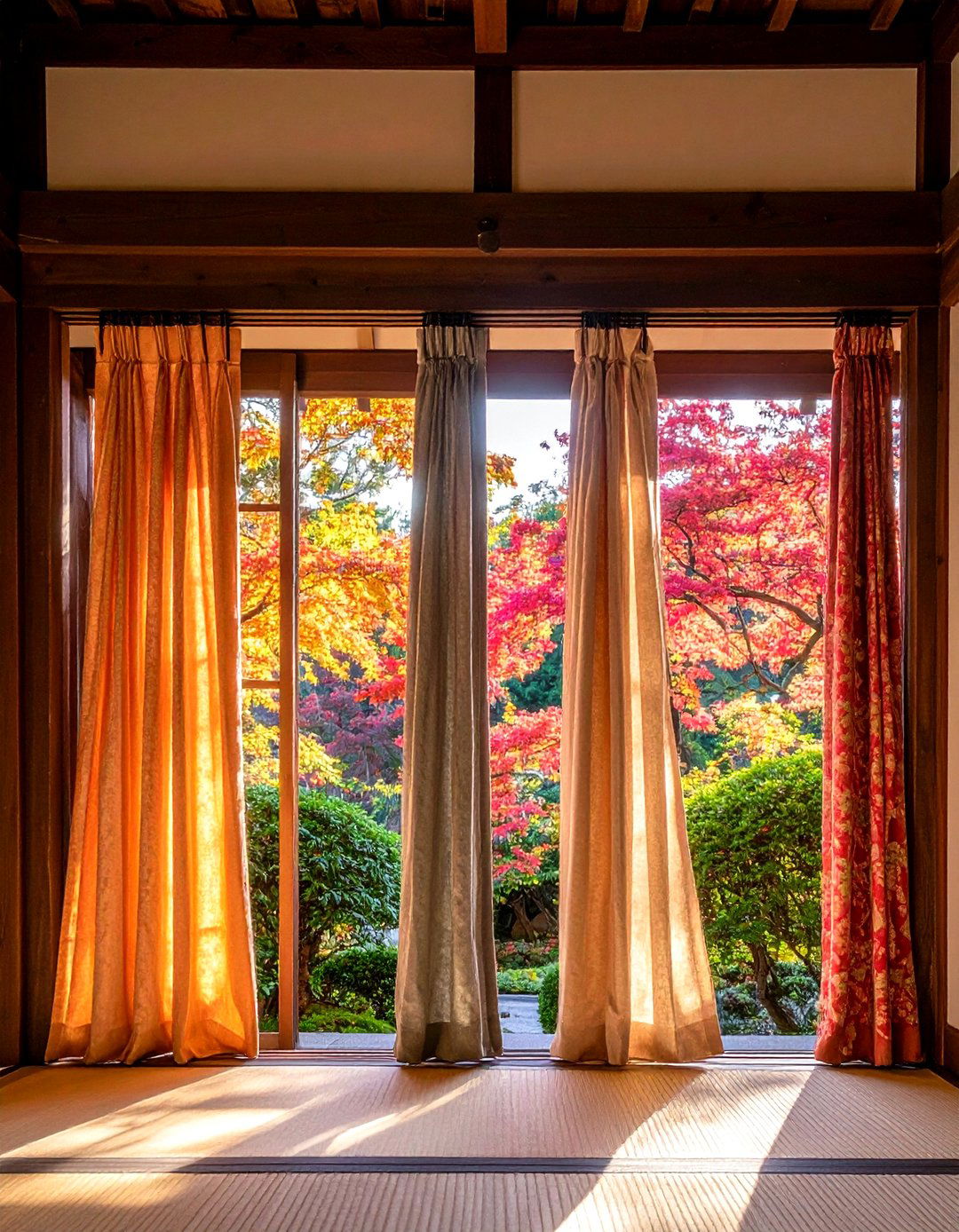
A noren is a hanging textile with one or more vertical slits, traditionally used as curtains at shop entrances and room dividers. These fabric panels add gentle movement and visual interest while maintaining flow between spaces. Noren historically served both functional and symbolic purposes, indicating when businesses were open or closed. Hang noren curtains in doorways, windows, or as room dividers to create subtle boundaries without blocking light or air circulation. A noren is often made from cotton, cotton/rayon-mixed, polyester or hemp, with cotton and cotton/rayon-mixed noren being softer. Choose fabrics in natural fibers with traditional patterns like waves, geometric designs, or seasonal motifs. The gentle movement of noren in breeze adds dynamic elements to static interiors while maintaining the peaceful atmosphere. Modern applications include using noren as decorative wall hangings or privacy screens for home offices. Select colors that complement your existing palette while adding subtle textural contrast through the fabric's drape and movement.
8. Japanese Interior Design Through Sustainable Furoshiki Decorative Wrapping Cloths
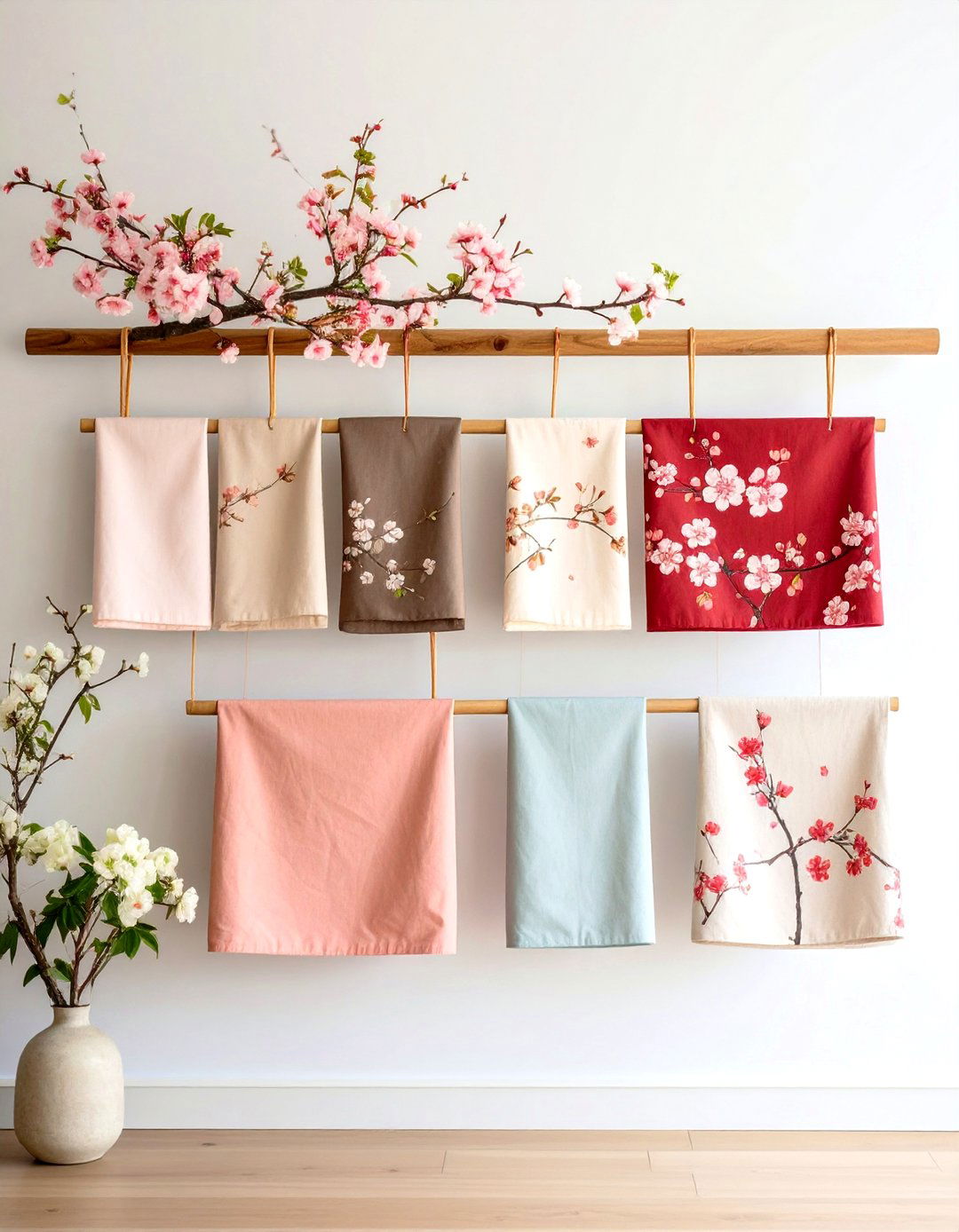
Furoshiki is a piece of square cloth for carrying items, traditionally used for gift wrapping to express the sender's mind and gratitude. These versatile textiles bring both practical function and aesthetic beauty to Japanese interior spaces. Recently, Furoshiki is getting popularity to exercise 3R (Recycle, Reuse and Reduce) lifestyle instead of wasting plastic bags. Display beautiful furoshiki as wall art by mounting them in simple frames or hanging them from wooden dowels. Use larger pieces as table runners, furniture covers, or room dividers that can be easily changed with seasons or occasions. The sustainable aspect of furoshiki aligns perfectly with modern eco-conscious living while honoring traditional Japanese values. Choose furoshiki in silk, cotton, or rayon featuring traditional patterns like cherry blossoms, geometric designs, or nature motifs. Furoshiki dimensions typically range from 50 cm to 120 cm square, offering various sizes for different decorative applications. The practice of folding and refolding furoshiki becomes a meditative ritual that connects you with Japanese cultural traditions.
9. Japanese Interior Design with Serene Genkan Entrance Transition Spaces
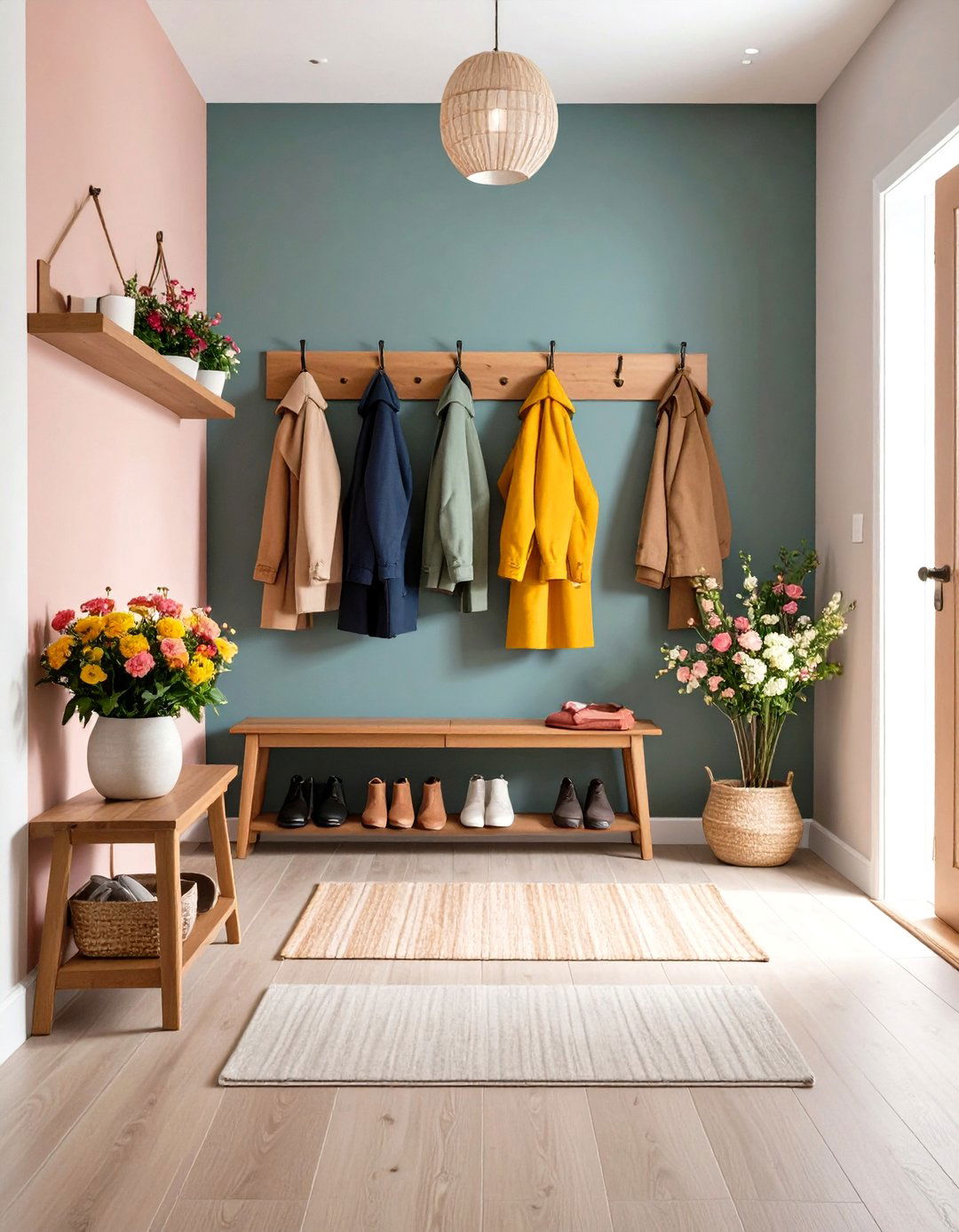
Genkan are traditional Japanese entryway areas where shoes are removed before entering the main part of the house, creating clear separation between outside and inside. This transitional space serves both practical and symbolic functions in Japanese homes. The genkan allows residents and visitors to transition from the outside world to the interior living space. Design a genkan-inspired entryway using different flooring materials to distinguish the transition zone from living areas. Install built-in storage for shoes, umbrellas, and outerwear to maintain organization and cleanliness. Care is generally taken to make the genkan an aesthetically pleasing space that demonstrates the character and taste of the occupants. Include a small bench for comfortable shoe changing and hooks for hanging coats. Add decorative elements like a single flower arrangement or meaningful artwork to create positive first impressions. The ritual of removing shoes in the genkan promotes mindfulness and respect for the sacred space of home while keeping interior floors clean for sitting and sleeping.
10. Japanese Interior Design Featuring Peaceful Engawa Indoor-Outdoor Verandas
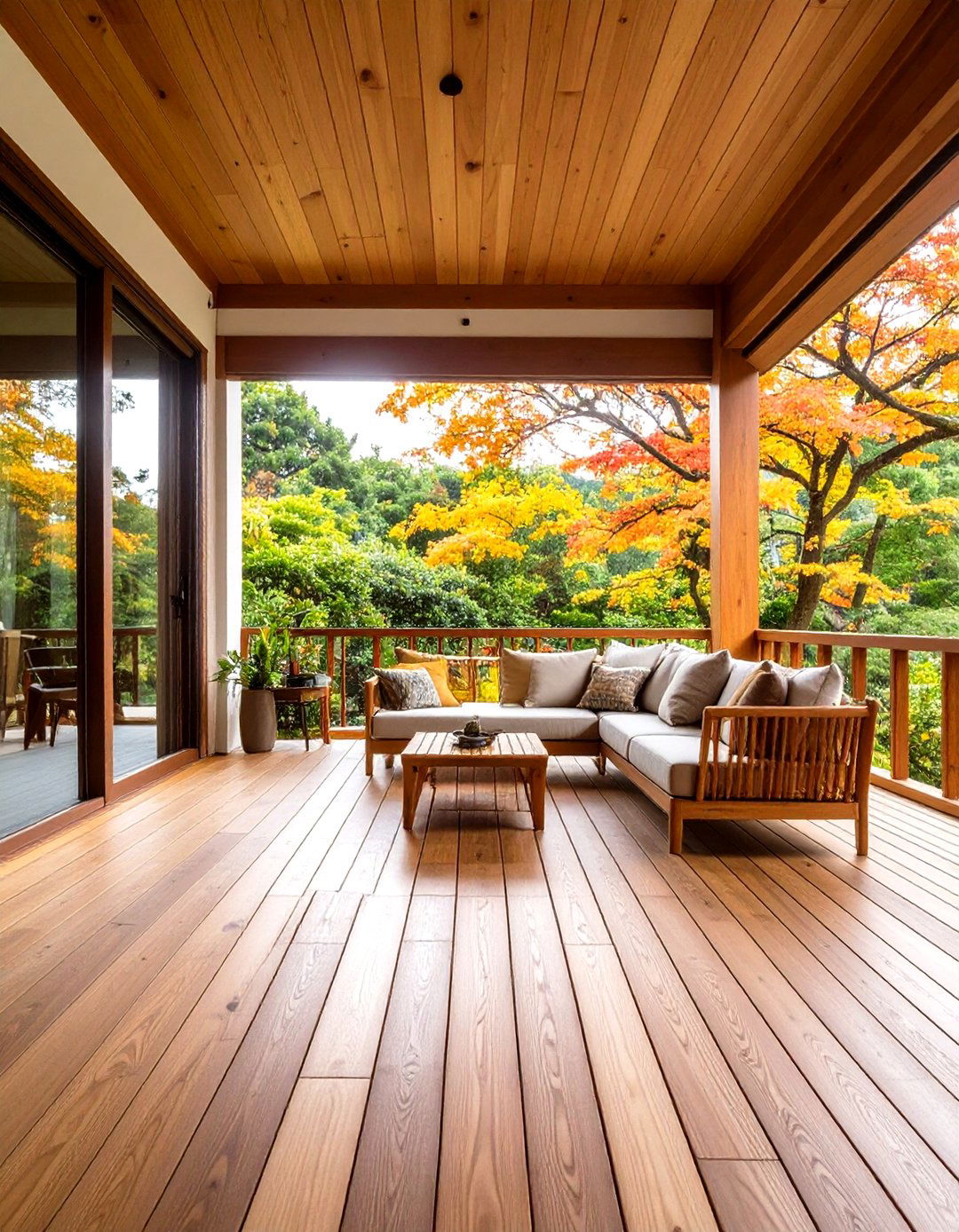
The engawa is a strip of wooden decking that exists between the periphery of the Japanese house and the garden, creating seamless transition between indoor and outdoor spaces. This architectural element promotes connection with nature while extending living areas. The engawa is an extension of living space that connects us to the outdoors and literally lets us breathe. Create engawa-inspired spaces using covered decks, sunrooms, or screened porches that blur interior-exterior boundaries. Use natural wood flooring that flows from interior spaces to outdoor areas, maintaining visual continuity. Engawa becomes the soft boundary between indoor and outdoor, where people would leave their shoes before stepping up. Install large sliding doors or windows that open completely to merge indoor and outdoor spaces during pleasant weather. Include comfortable seating for meditation, tea drinking, or simply observing nature's changing seasons. The engawa philosophy encourages slowing down and appreciating simple moments while maintaining connection to the natural world through thoughtful architectural design that honors traditional Japanese wisdom.
11. Japanese Interior Design Using Contemplative Zen Garden Indoor Landscapes
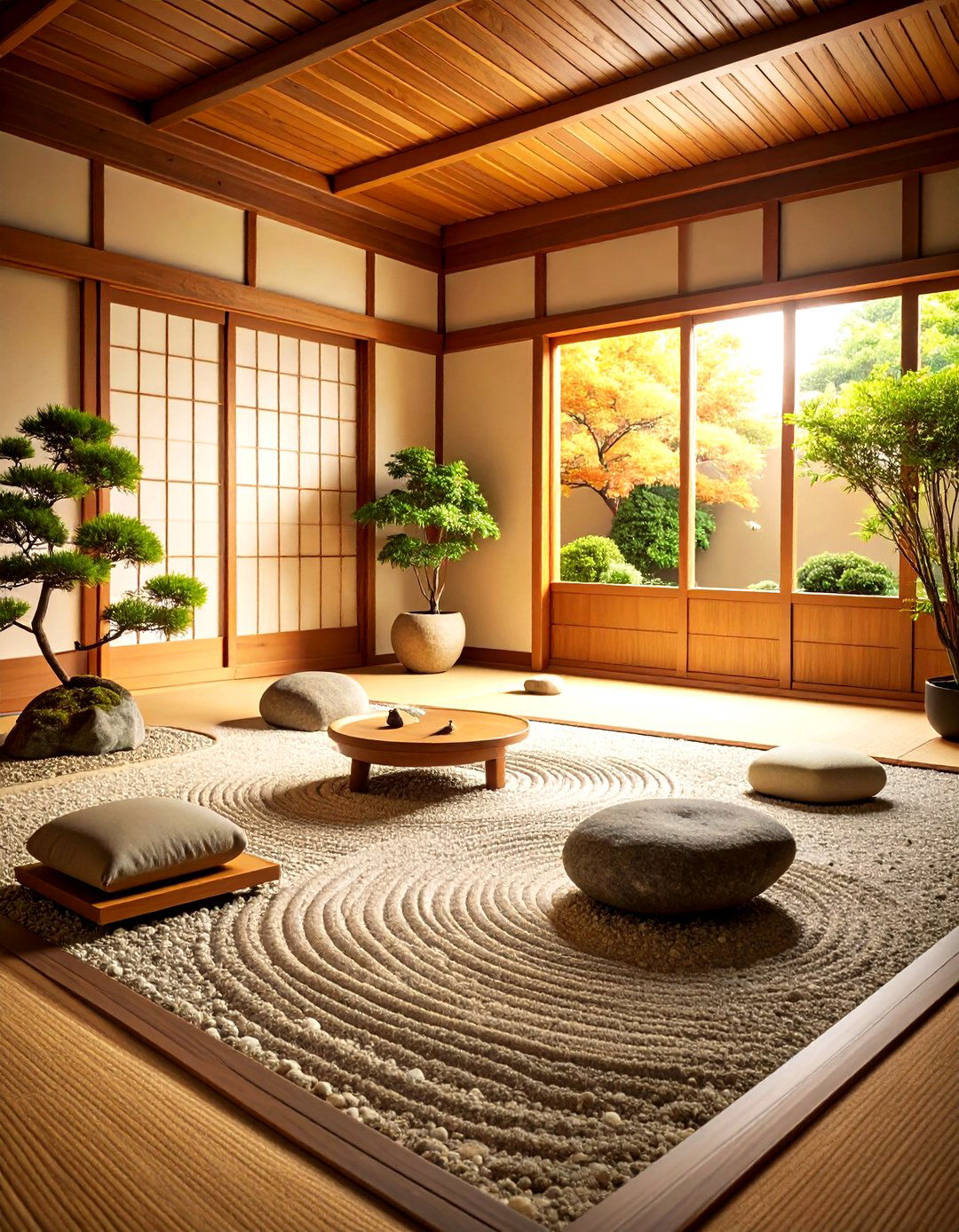
Zen gardens, also known as Karesansui, offer soothing visual retreat featuring carefully raked gravel, rocks, and minimalistic plantings that mimic natural landscapes. These meditative spaces bring tranquility and focused contemplation into interior environments. Create miniature zen gardens using shallow wooden trays filled with fine sand or gravel, placing carefully selected stones to represent mountains or islands. They create a serene environment perfect for meditation and relaxation, helping to clear the mind and restore balance. Include small rakes for the meditative practice of creating patterns in the sand, which promotes mindfulness and stress relief. Position zen gardens near windows where natural light can highlight the subtle textures and shadows. Larger installations can incorporate actual stone elements and drought-resistant plants like mosses or small succulents. The abstract representations in zen gardens encourage personal interpretation and contemplation, making them powerful tools for mental clarity. Regular maintenance of raking patterns becomes a moving meditation that connects you with Japanese spiritual traditions while providing peaceful focal points for daily reflection.
12. Japanese Interior Design with Flexible Fusuma Sliding Paper Doors
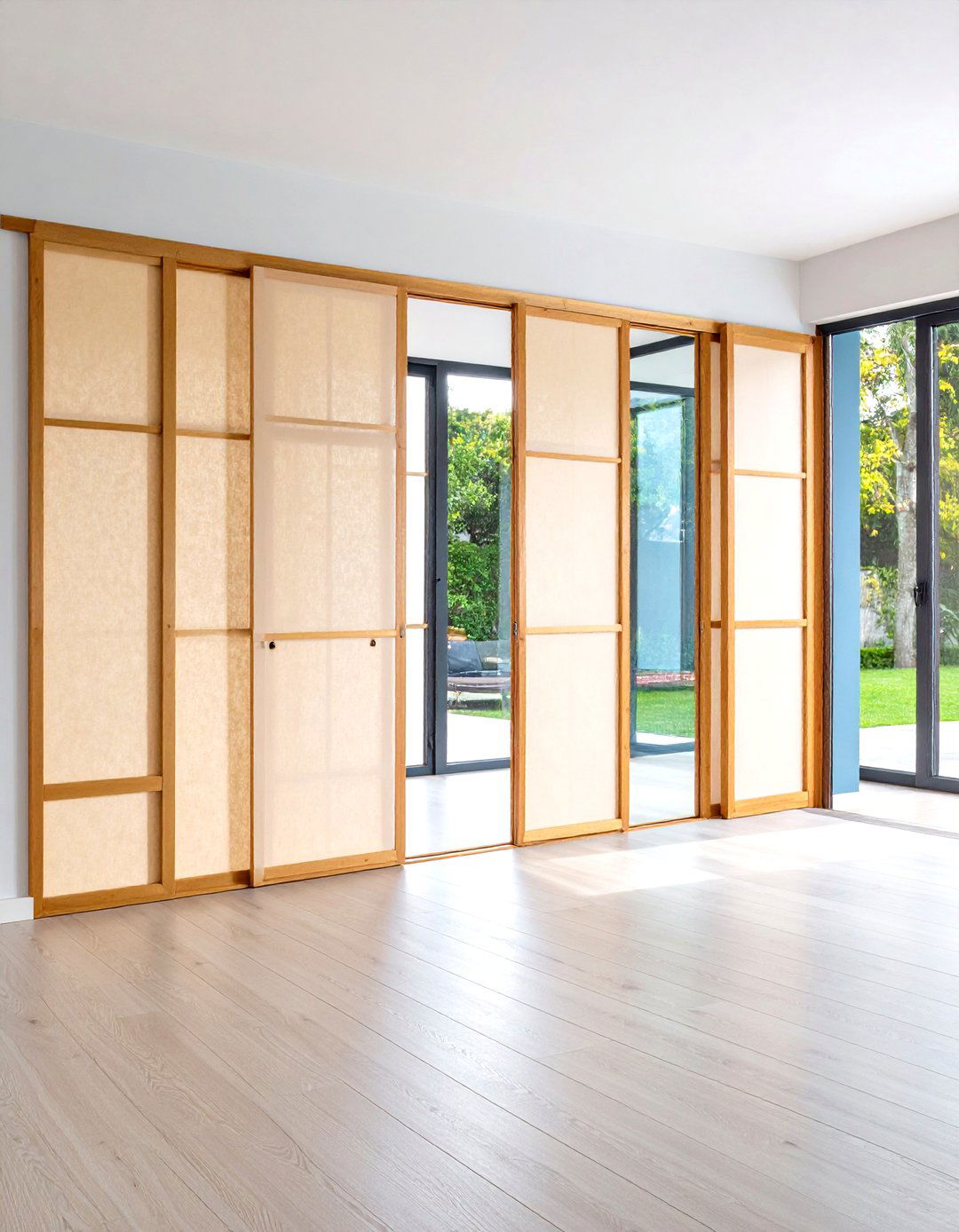
Fusuma are sliding doors made up of wooden frames covered in thick, opaque paper, typically used between adjoining rooms like large removable walls. These adaptable panels allow spaces to be partitioned or opened as needed, creating flexible living arrangements. Fusuma doors are sliding panels used to redefine interior spaces creatively, offering both functional and decorative versatility. Install fusuma-style sliding panels to create multipurpose rooms that can be quickly reconfigured for different activities. Traditional fusuma featured elaborate paintings, but modern interpretations can use solid colors, subtle patterns, or contemporary artwork. Fusuma allow one to partition off areas or open up space as needed. Choose lightweight frames that slide smoothly on tracks, making space transformation effortless. The opaque panels provide privacy when needed while maintaining the option for open, flowing layouts. Use fusuma to separate work areas from living spaces, create temporary guest rooms, or divide children's play areas. The ability to quickly reconfigure spaces makes small homes more functional while honoring traditional Japanese architectural principles of adaptability and efficient space utilization.
13. Japanese Interior Design Through Harmonious Low-Profile Platform Bed Systems
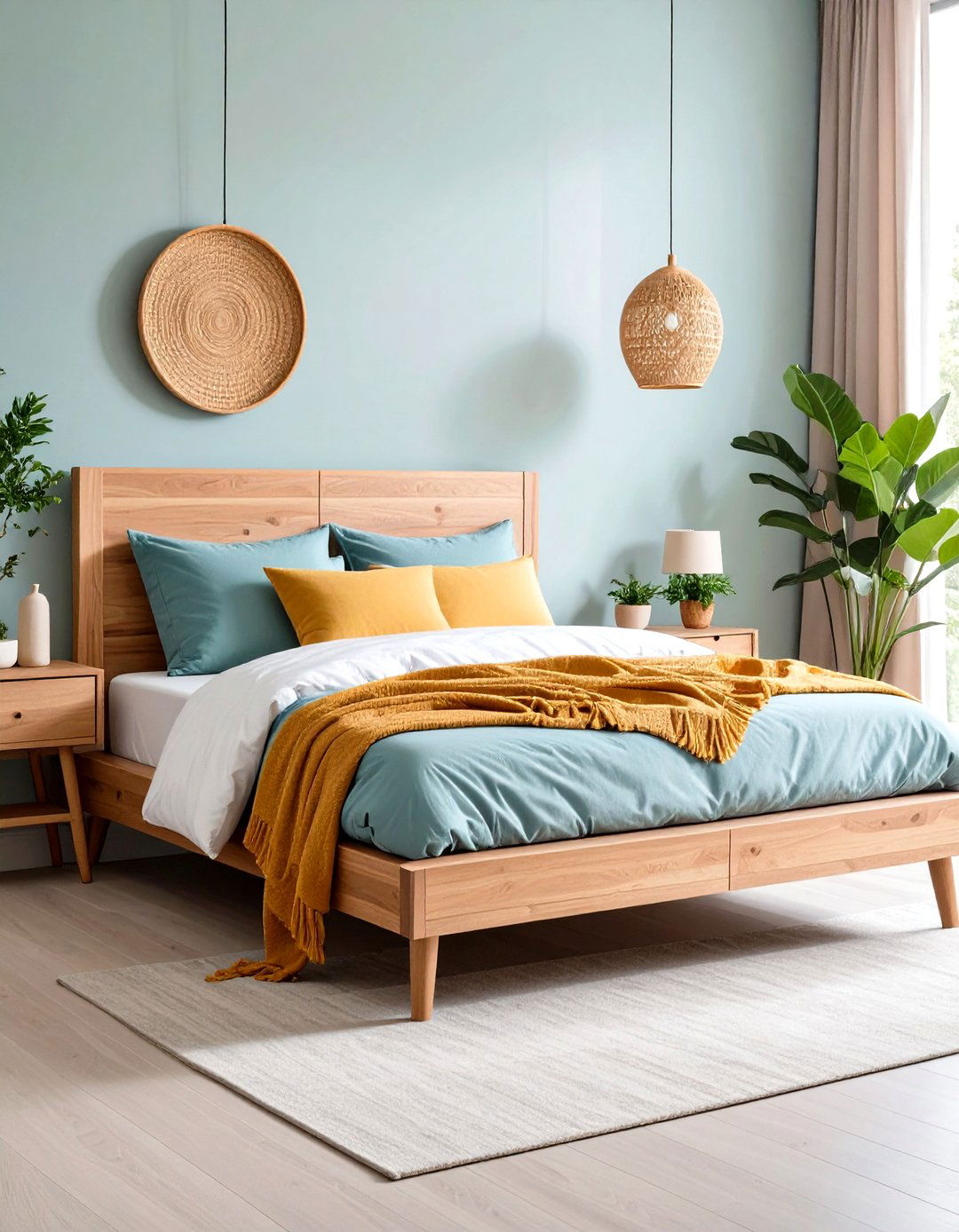
Japanese interior design platform beds emphasize simplicity and connection to the earth through low-profile sleeping arrangements that promote restful sleep and mental clarity. These minimalist bed frames eliminate unnecessary height and ornamentation, focusing attention on clean lines and natural materials. Choose solid wood construction using species like oak, maple, or traditional cedar for authentic appeal and durability. The low height encourages a humble sleeping posture that connects occupants with traditional Japanese values of modesty and groundedness. Platform beds work perfectly with futon mattresses or thin, firm mattresses that support healthy sleeping postures. Include built-in storage drawers or shelving that maintain the clean aesthetic while maximizing functionality in small spaces. Position beds near windows to take advantage of natural light for waking and provide views of gardens or natural elements. The unadorned design creates peaceful sleeping environments free from visual distractions. Combine platform beds with neutral bedding in natural fibers like linen or cotton to complete the serene, minimalist bedroom aesthetic that promotes quality rest and mental tranquility.
14. Japanese Interior Design Using Strategic Natural Light Maximization Techniques
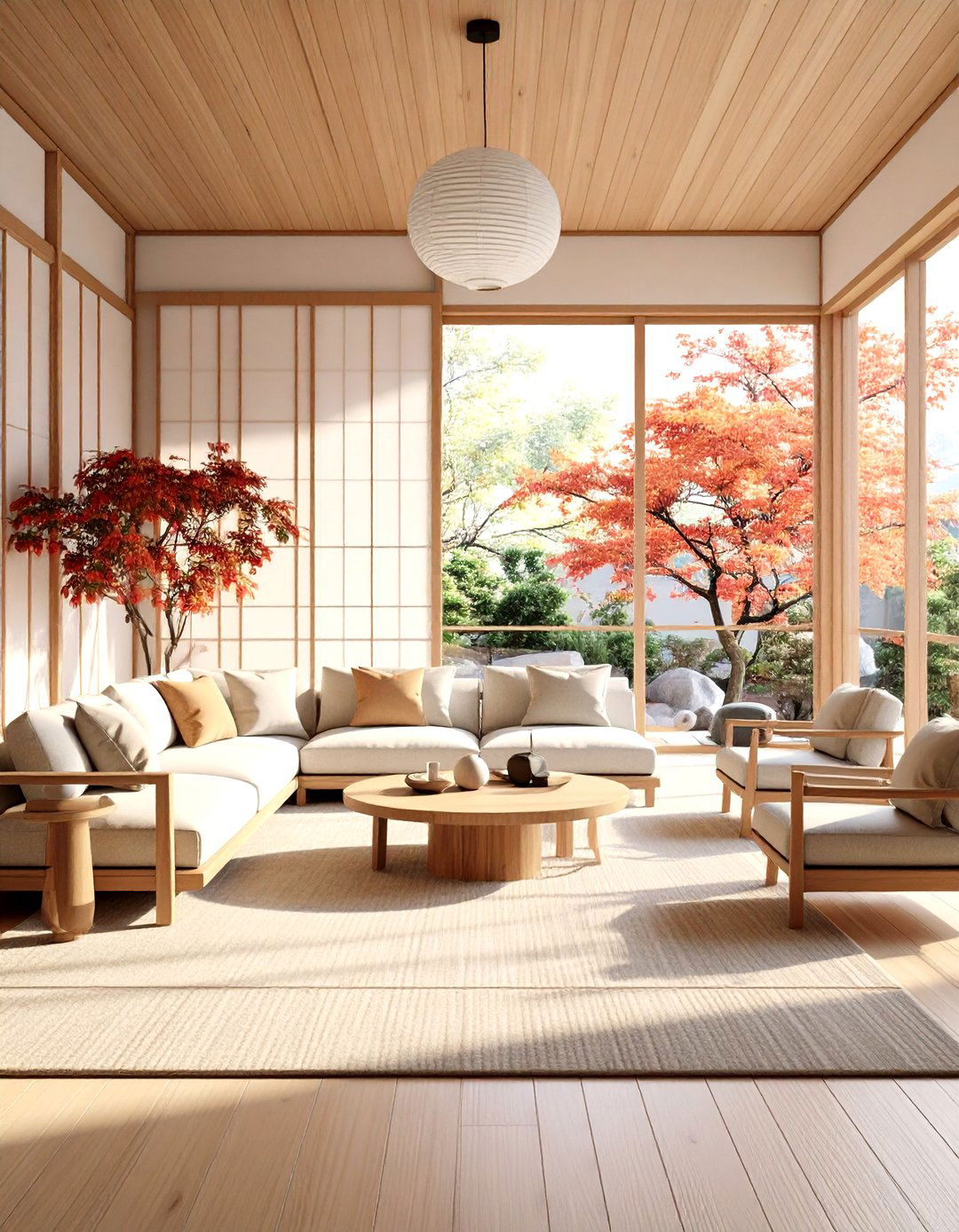
Maximizing natural light is essential in Japanese interior design, embodying the philosophy of shizen, which recognizes harmony between people and nature. This approach creates bright, airy spaces that change throughout the day with shifting sunlight patterns. Incorporate large windows and glass doors in your design to enhance natural light throughout the space effectively. Remove heavy window treatments in favor of shoji screens or lightweight linen panels that filter rather than block light. Position mirrors strategically to reflect and amplify available daylight throughout interior spaces. Choose light-colored wall finishes and reflective surfaces that bounce natural illumination deeper into rooms. Install skylights or clerestory windows where possible to bring light from above, mimicking the traditional Japanese appreciation for changing sky conditions. The use of wooden materials works in tandem with light to create an inviting atmosphere that reflects Japanese craftsmanship and aesthetics. Trim back landscaping near windows to maximize light penetration while maintaining privacy through thoughtful plant placement. The goal is creating spaces that feel connected to outdoor light cycles, promoting natural circadian rhythms and overall wellbeing.
15. Japanese Interior Design Incorporating Sacred Ma Negative Space Principles
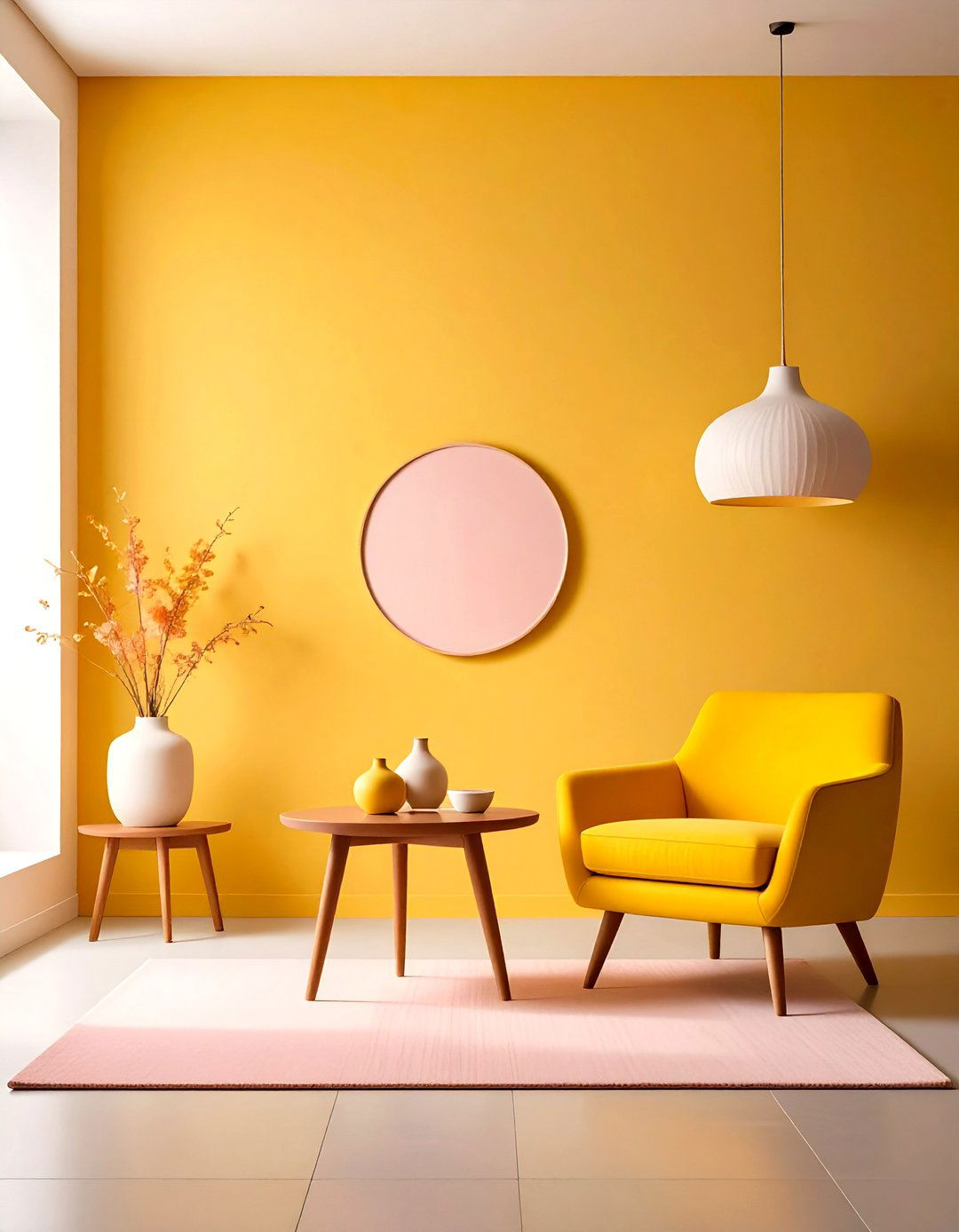
The concept of "ma," which highlights the importance of negative space, is central to achieving balance and harmony in Japanese interiors. This philosophical approach values empty space as much as filled areas, creating breathing room for both objects and occupants. Ma teaches that pauses and emptiness are essential elements that give meaning to what surrounds them. Design rooms with generous amounts of unoccupied space between furniture pieces, allowing each element to be appreciated individually. Avoid filling every wall surface or corner with decorative objects, instead choosing fewer, more meaningful pieces that can be properly contemplated. Ma embraces the negative space of a room and is used as a design style to embrace void. Create visual rest areas using empty walls, clear surfaces, and uncluttered arrangements that promote mental clarity and reduced stress. Position single, significant objects in otherwise empty spaces to highlight their importance and beauty. The practice of ma encourages editing possessions down to essentials, keeping only items that serve specific purposes or bring genuine joy. This mindful approach to space creates environments that feel spacious regardless of actual square footage.
16. Japanese Interior Design Using Earth-Tone Natural Color Palette Harmony

Japanese interior design earth-tone color palettes draw inspiration from natural landscapes, incorporating warm browns, soft grays, muted greens, and cream tones that create calming, cohesive environments. These organic hues reflect traditional Japanese appreciation for seasonal changes and natural beauty found in stones, wood, clay, and growing plants. Choose warm beiges and taupe shades that evoke sun-dried earth and weathered wood surfaces. Include soft sage greens reminiscent of moss and bamboo, balanced with charcoal grays that reference river stones and mountain landscapes. Wabi Sabi interiors highlight the natural beauty of materials and textures with muted color palettes, without the distraction of bold or bright colors. Add ochre and rust accents that mirror autumn leaves and clay pottery glazes. Layer different textures within the same color family to create visual interest without overwhelming the senses. Use natural white and cream tones as foundation colors that allow wood grains and stone textures to become focal points. This restrained approach to color creates timeless spaces that feel connected to nature while promoting the peaceful, meditative atmosphere essential to Japanese design philosophy.
17. Japanese Interior Design with Handcrafted Artisan Object Displays
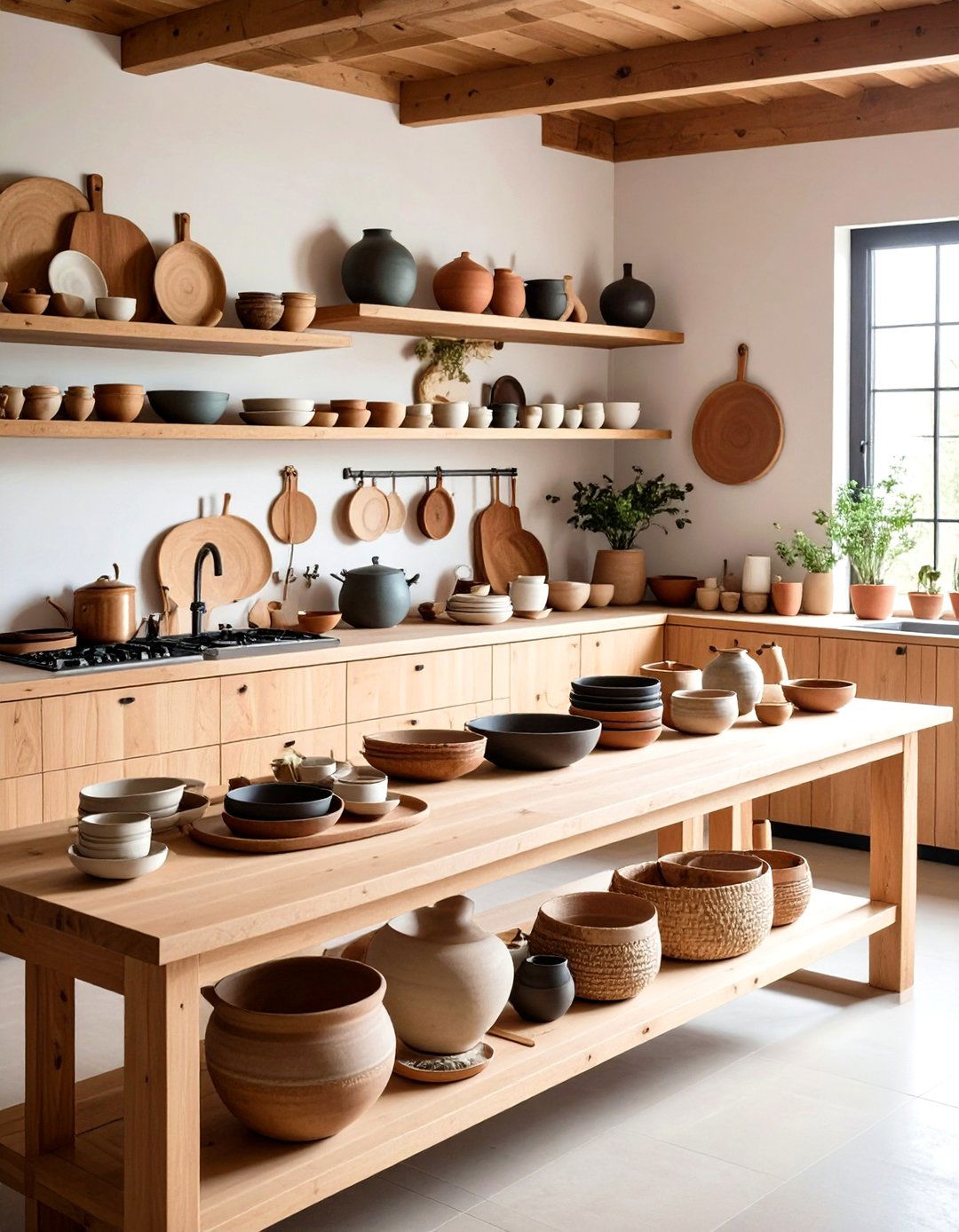
The world of wabi-sabi thrives on handcrafted objects, treasures bearing the unmistakable marks of human touch. These unique pieces bring authenticity and soul to Japanese interior spaces through their imperfect beauty and individual character. Japanese concepts prefer raw, organic and noble materials, always choosing the useful over the superfluous, giving pride of place to handicrafts and unique objects. Select pottery with visible fingerprints from the potter's wheel, woodwork showing chisel marks, or textiles with slight irregularities that reveal their handmade origins. Display these treasures thoughtfully, allowing each piece space to be appreciated individually rather than clustering multiple objects together. Choose ceramics glazed in natural tones with subtle variations that reflect firing processes and clay characteristics. Include hand-forged metal objects like iron kettles or copper vessels that develop beautiful patina over time. Pottery is an ancient art form in Japan, generally rough and organic with function over form, featuring muted complex color and natural ease of use. Support contemporary artisans working in traditional techniques, bringing living culture into your home while honoring ancient craftsmanship traditions through mindful object selection and display.
18. Japanese Interior Design Through Seasonal Element Rotation Practices
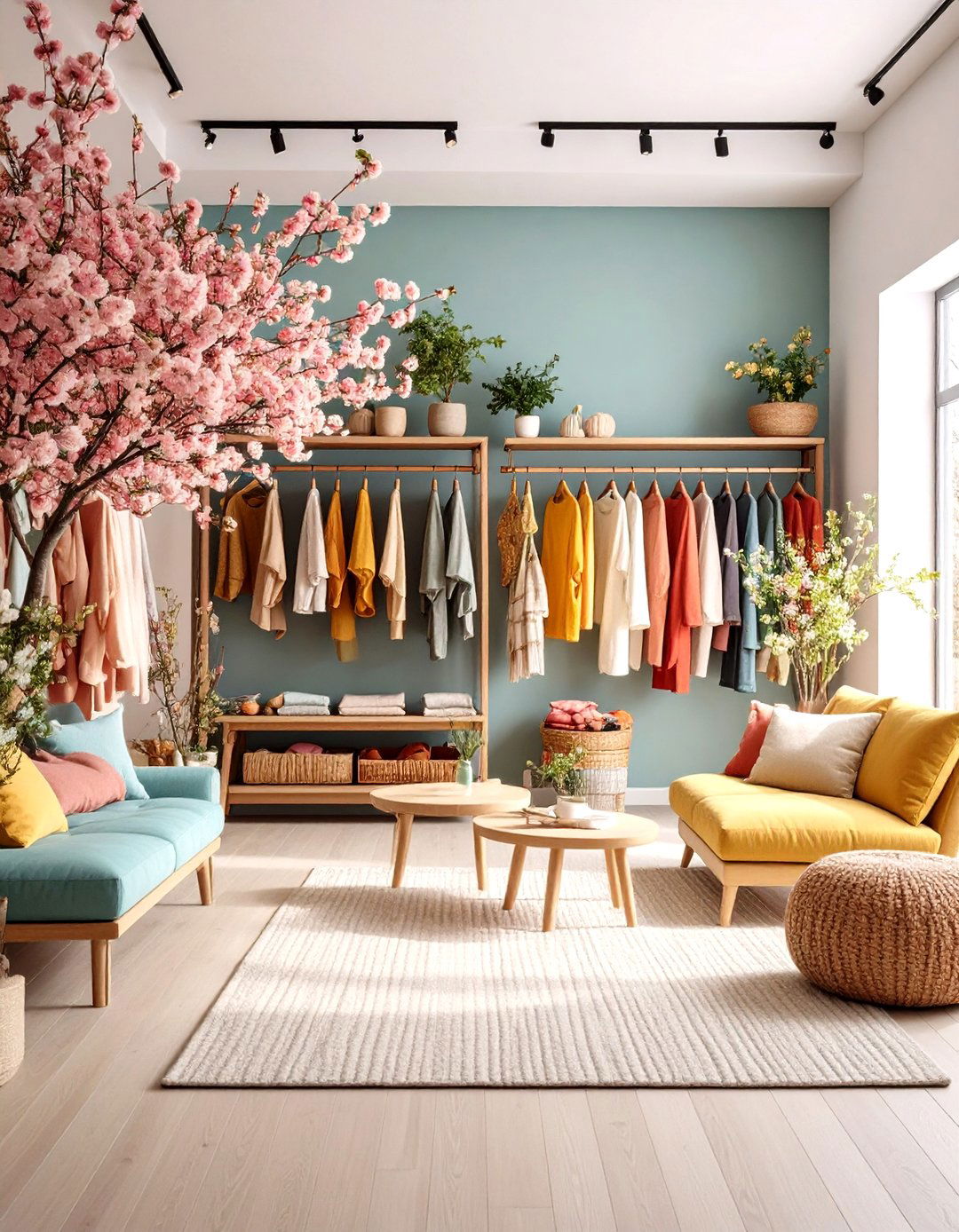
Japanese interior design seasonal rotation practices honor the natural world's changing cycles by regularly updating decorative elements to reflect current seasons and maintain fresh, dynamic living spaces. This approach prevents staleness while encouraging mindfulness of time's passage and nature's rhythms. Items displayed in tokonoma are chosen carefully based on the season, with floral arrangements changed frequently for special occasions. Store decorative objects in organized collections, rotating artwork, textiles, and accessories every three months to match seasonal transitions. Display spring cherry blossom branches in March, summer hydrangeas in July, autumn maple leaves in October, and winter evergreen arrangements in December. Change cushion covers, table runners, and wall hangings to reflect seasonal color palettes and natural themes. You can switch out items in your design alcove with the season, with the day of the week, or simply because you're bored. Include seasonal lighting adjustments, using warmer tones in winter and cooler tones in summer. This practice keeps interiors feeling alive and connected to the natural world while preventing accumulation of unnecessary objects. Regular rotation encourages appreciation of each item's unique beauty and seasonal appropriateness.
19. Japanese Interior Design with Meditative Tea Ceremony Corner Spaces
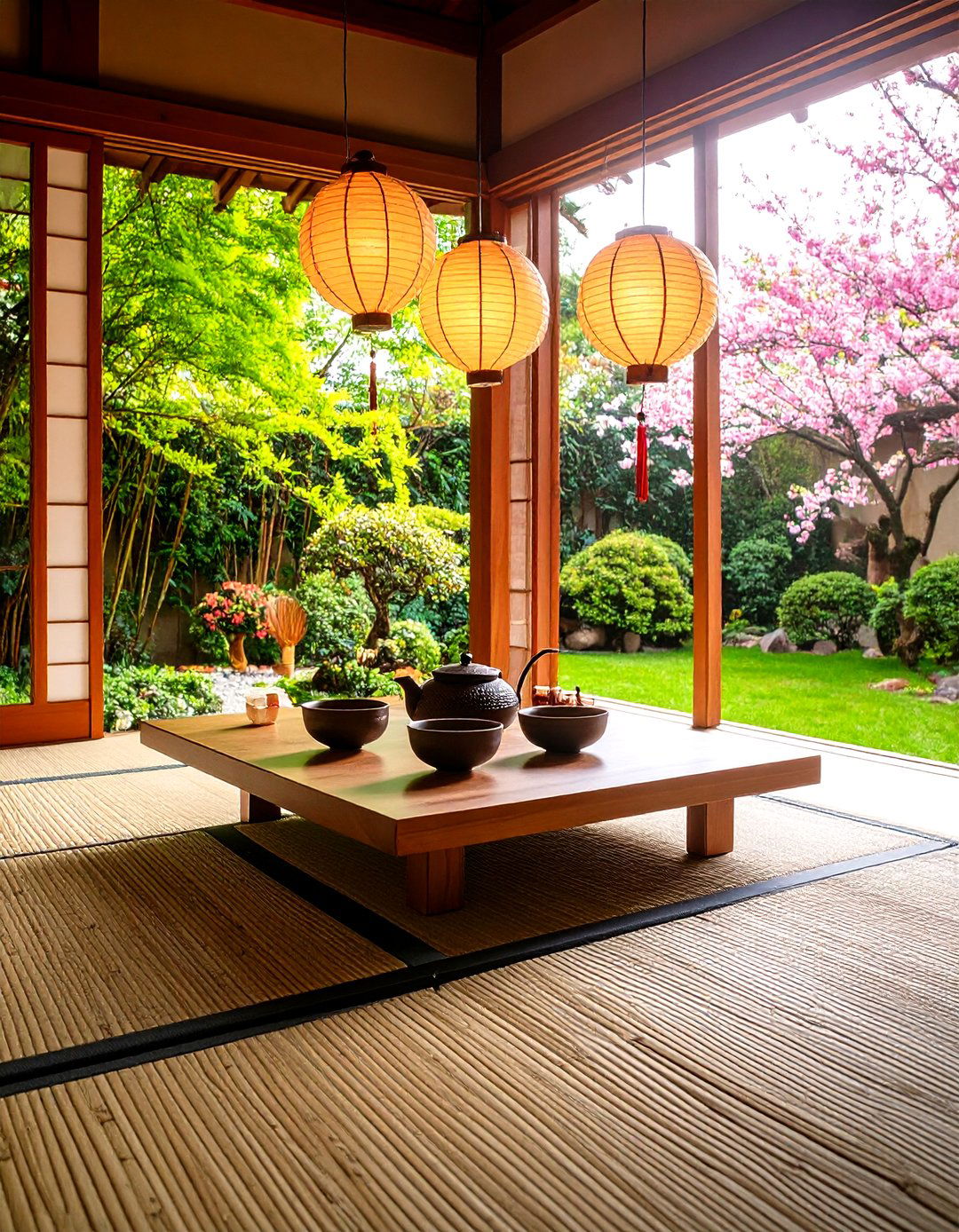
Japanese interior design tea ceremony corners create dedicated spaces for mindful ritual and contemplation, incorporating traditional elements that promote inner peace and cultural connection. These intimate areas honor the Japanese tea ceremony's emphasis on simplicity, respect, and present-moment awareness. Designate a quiet corner with tatami mats or cushions for comfortable kneeling or sitting during tea preparation and consumption. Include low tables specifically sized for tea implements, allowing for graceful movements and proper ceremony protocols. The Japanese Tea Ceremony celebrates the beauty of time and place, honoring objects, tea, and the people who join. Display beautiful ceramic tea bowls, bamboo whisks, and iron kettles that embody traditional craftsmanship and aesthetic principles. Incorporate subtle lighting from paper lanterns or candles to create atmospheric illumination suitable for contemplation. Position the tea area near windows overlooking gardens or natural views to enhance the sense of seasonal connection. Include storage for tea implements in beautiful wooden boxes or baskets that maintain the aesthetic when not in use. The tea corner becomes a sanctuary for daily meditation and mindful practices that connect inhabitants with centuries of Japanese cultural wisdom.
20. Japanese Interior Design Through Sustainable Bamboo Material Integration
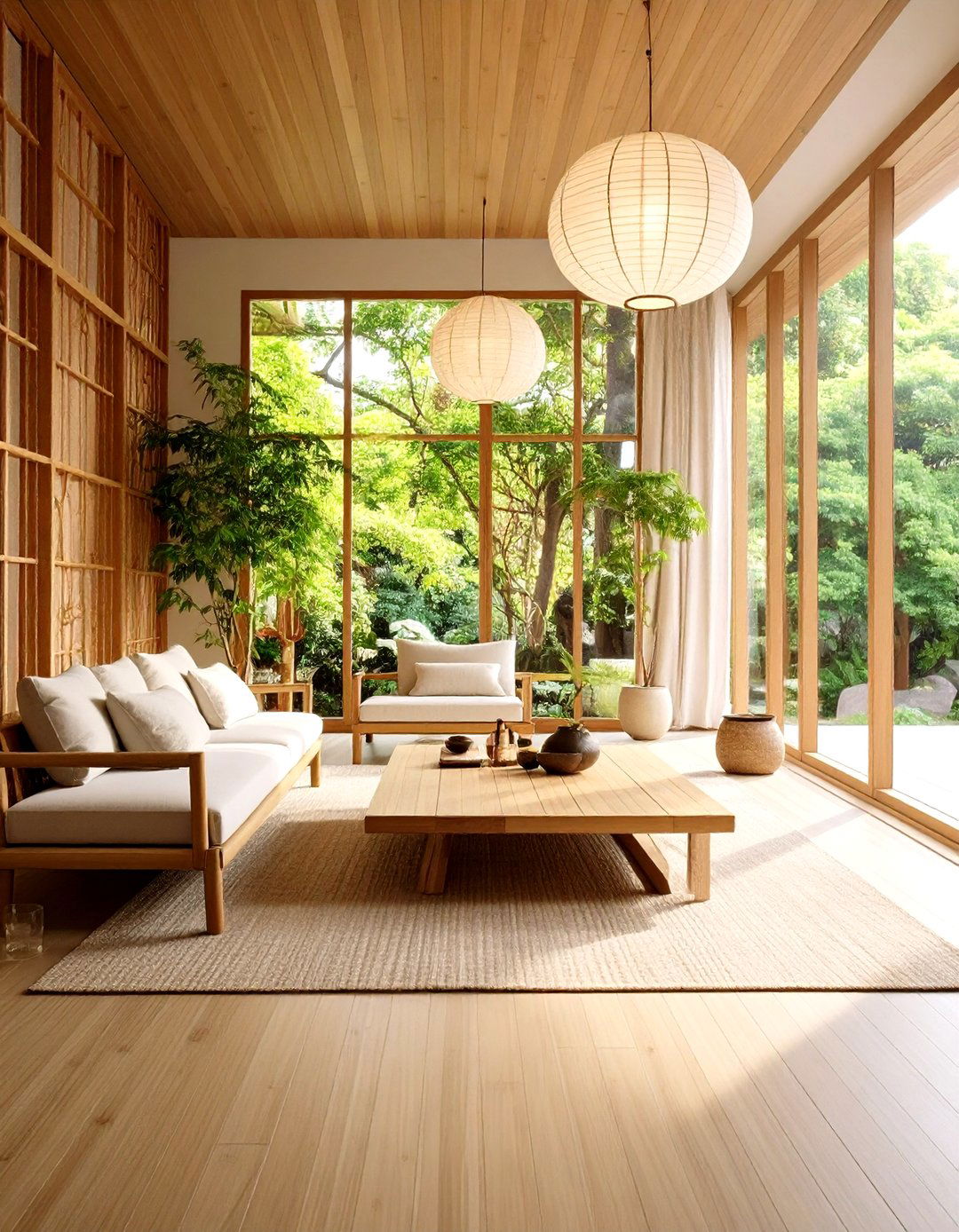
Japanese interior design sustainable bamboo integration honors this versatile plant's cultural significance while providing eco-friendly alternatives to traditional hardwoods in contemporary living spaces. Bamboo is prominently used in Japanese design, often left in its natural state to emphasize inherent beauty and connection to nature. Bamboo's rapid growth and renewability make it an ideal choice for environmentally conscious homeowners seeking authentic Japanese aesthetics. Use bamboo flooring for its durability, natural antimicrobial properties, and beautiful grain patterns that add warmth to any room. Include bamboo furniture pieces like low tables, room dividers, and storage solutions that showcase the material's natural nodes and organic variations. Install bamboo blinds or screens that filter light while maintaining privacy and connection to natural elements. Traditional Japanese construction uses bamboo for its flexibility and strength in various architectural applications. Choose bamboo accessories like vases, trays, and decorative panels that highlight the material's natural beauty and sustainability credentials. The hollow structure and segmented growth pattern of bamboo symbolize emptiness and renewal in Japanese philosophy, making it perfect for creating spaces that promote spiritual growth and environmental responsibility while maintaining authentic aesthetic connections to traditional Japanese culture.
Conclusion:
Japanese interior design offers timeless principles for creating harmonious, mindful living spaces that nurture both physical comfort and spiritual wellbeing. By incorporating elements like tatami mats, shoji screens, natural materials, and thoughtful spatial arrangements, you can transform any home into a serene sanctuary. The emphasis on simplicity, seasonal awareness, and connection to nature provides antidotes to modern life's complexity while honoring centuries of refined aesthetic wisdom. Whether adopting single elements or embracing comprehensive design philosophy, Japanese principles encourage mindful living through beautiful, functional spaces that promote inner peace and authentic connection to the natural world around us.



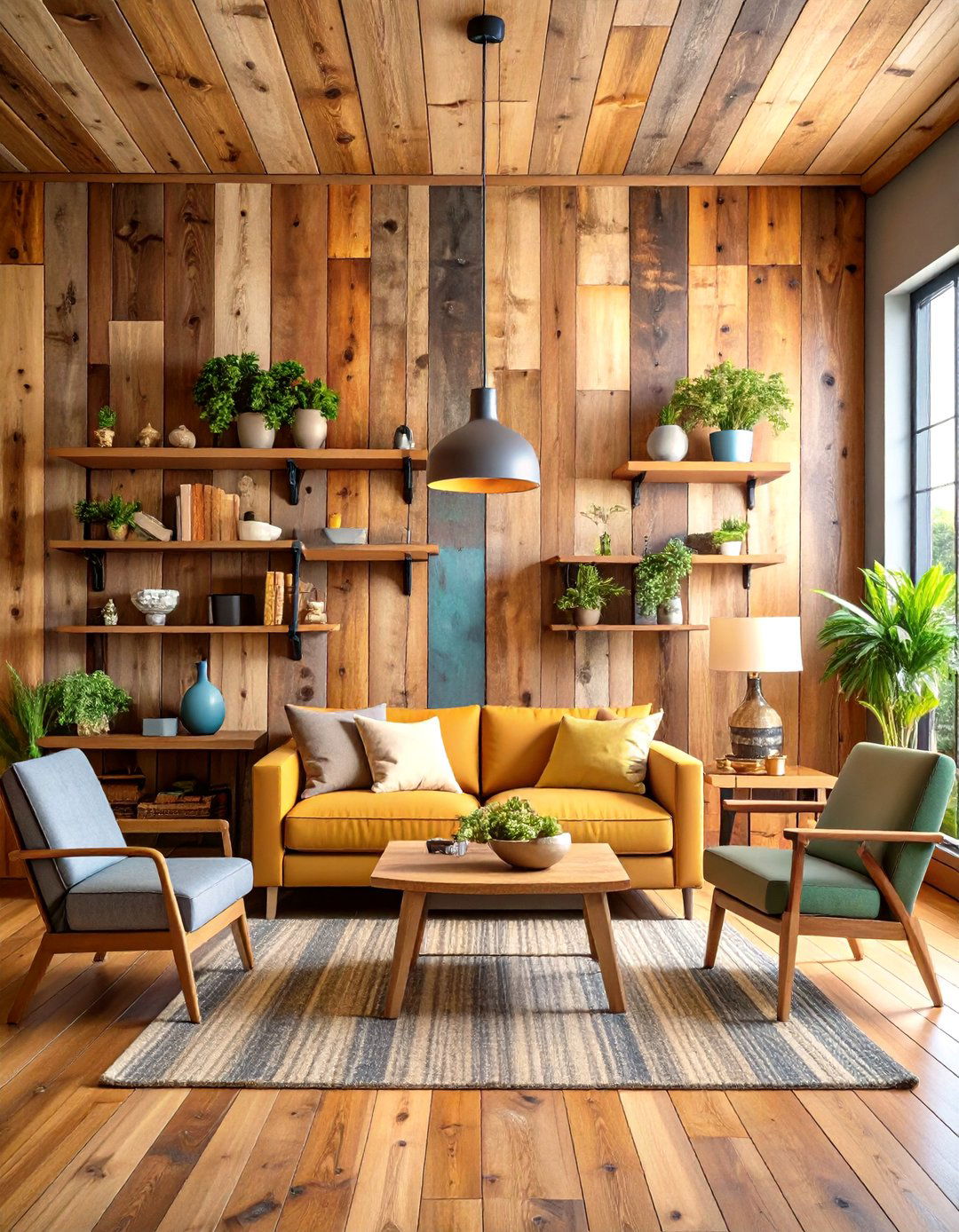
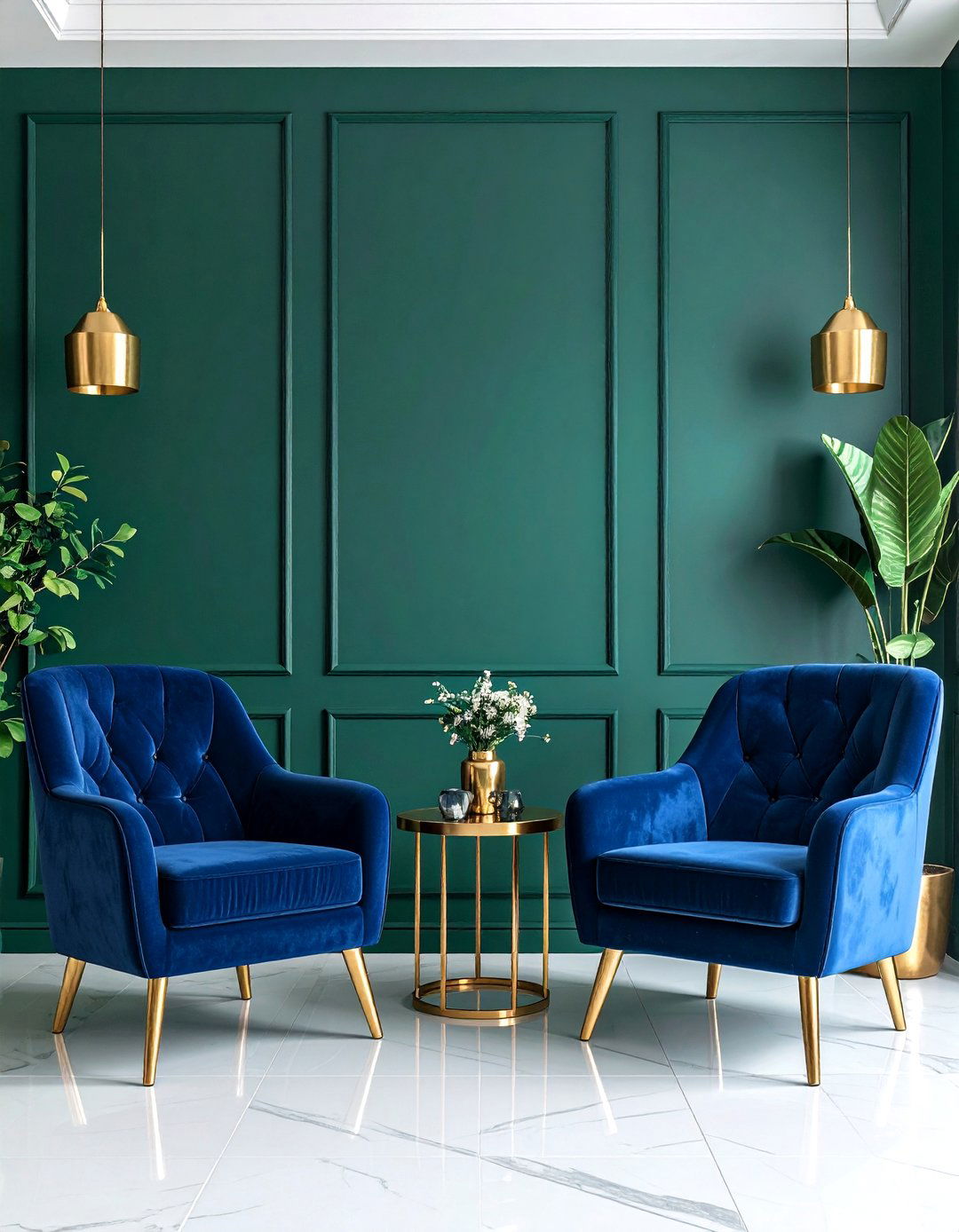
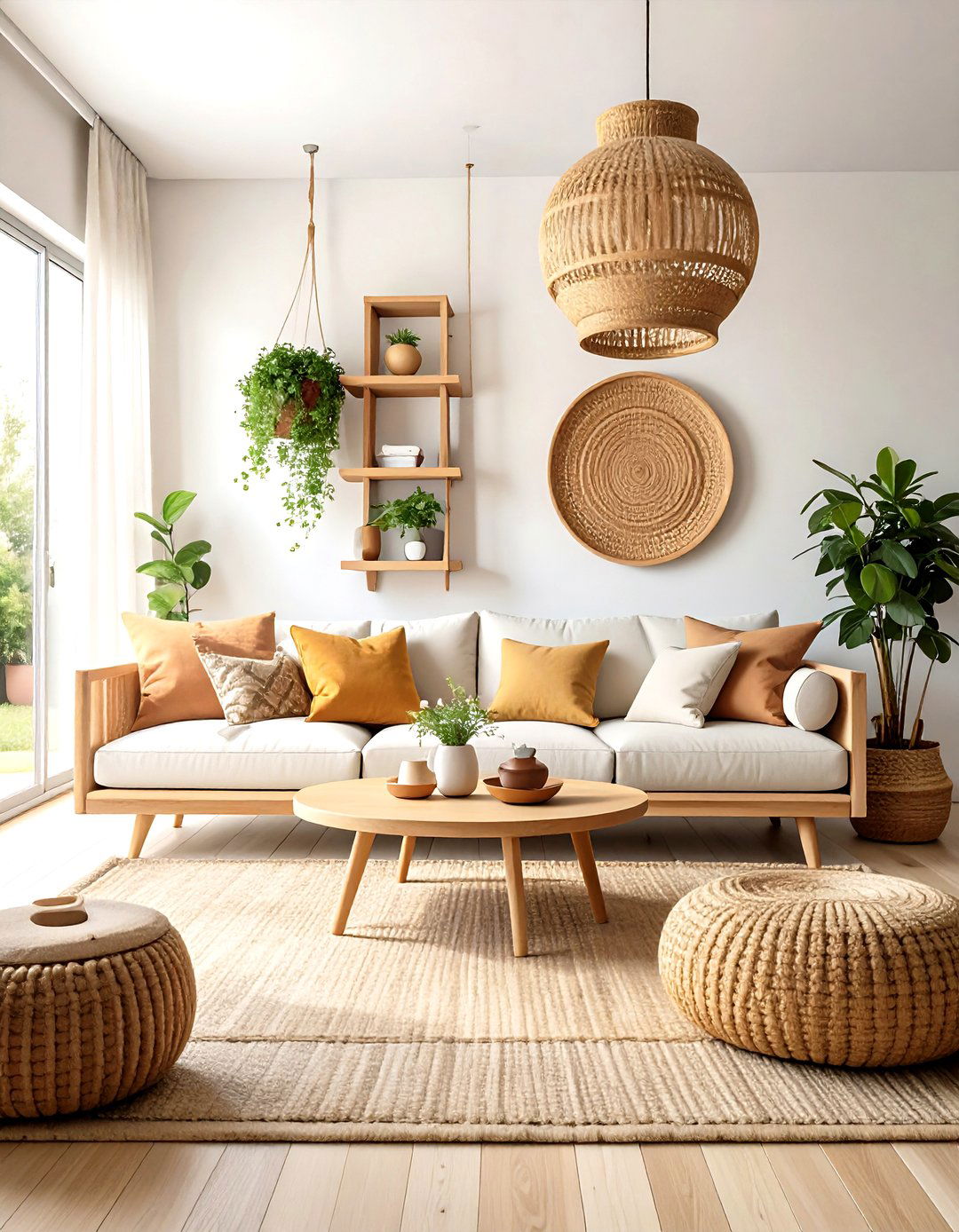
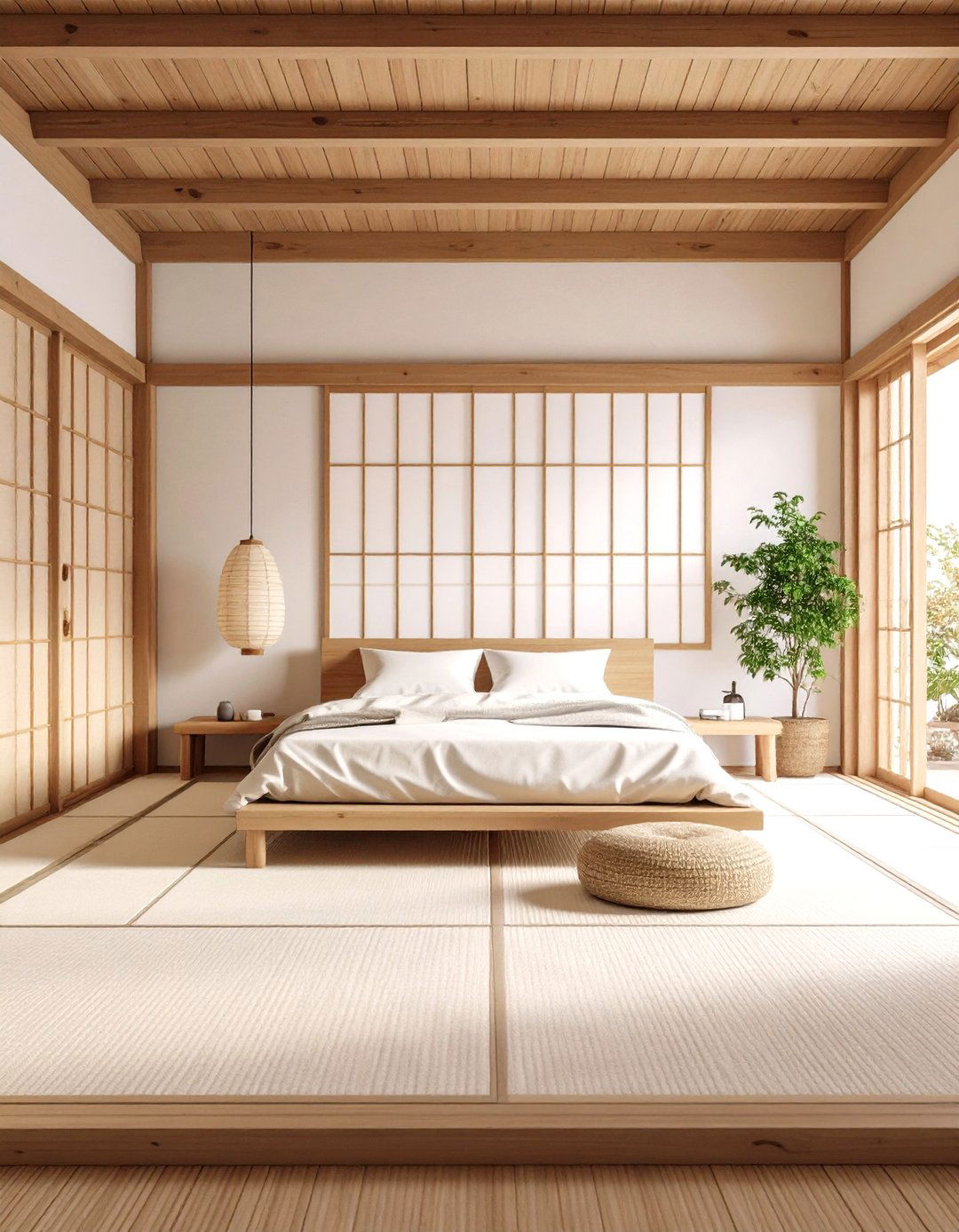
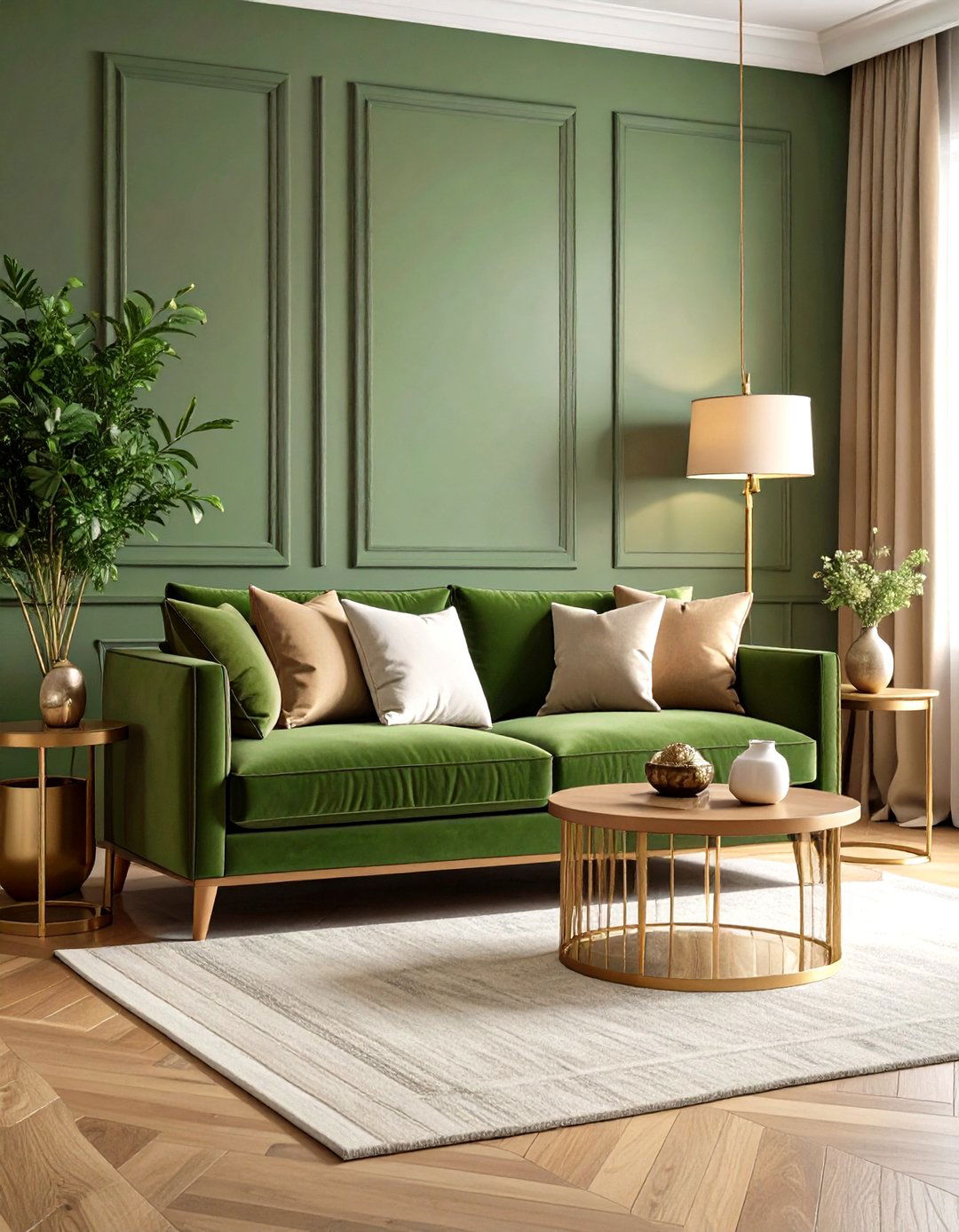

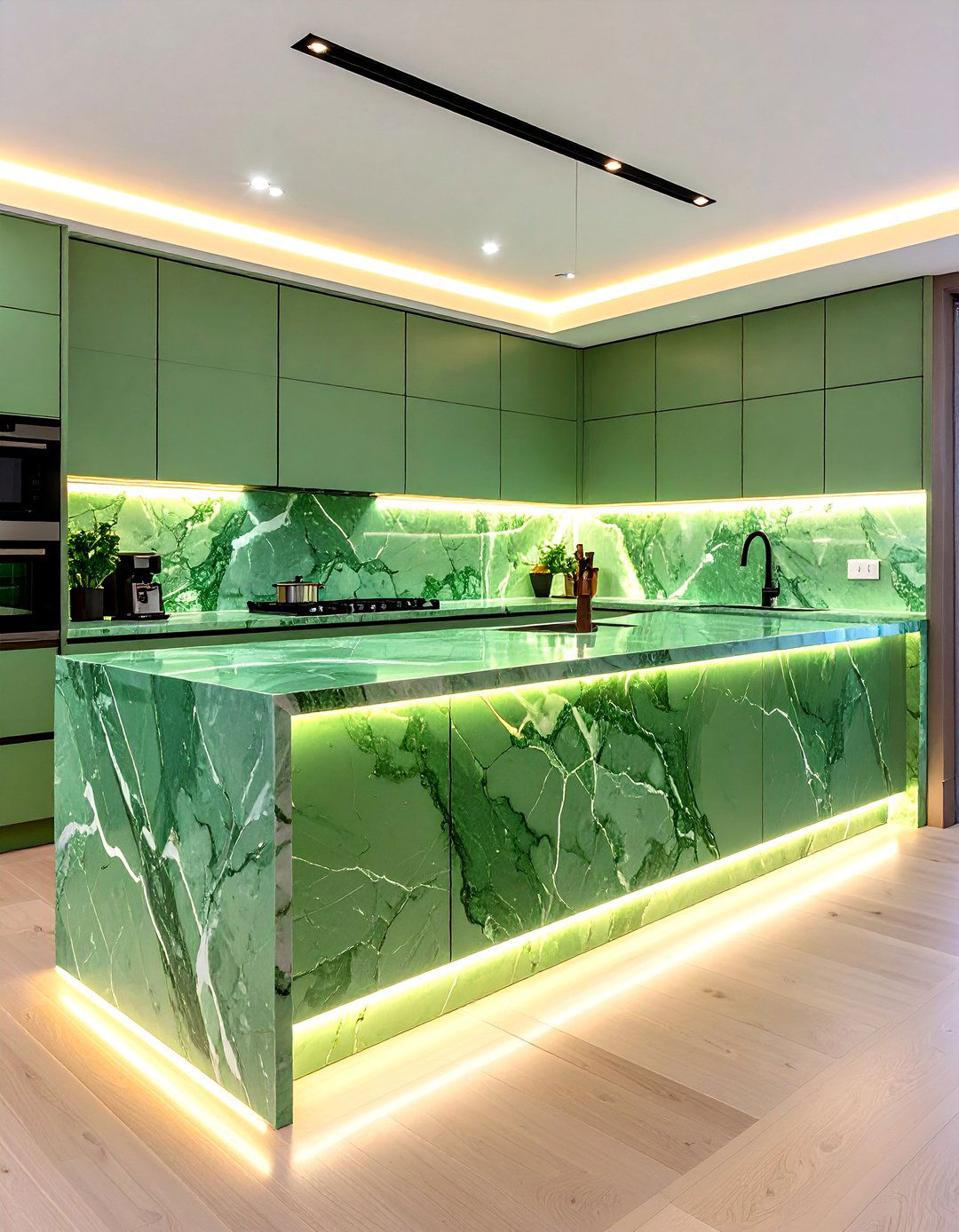

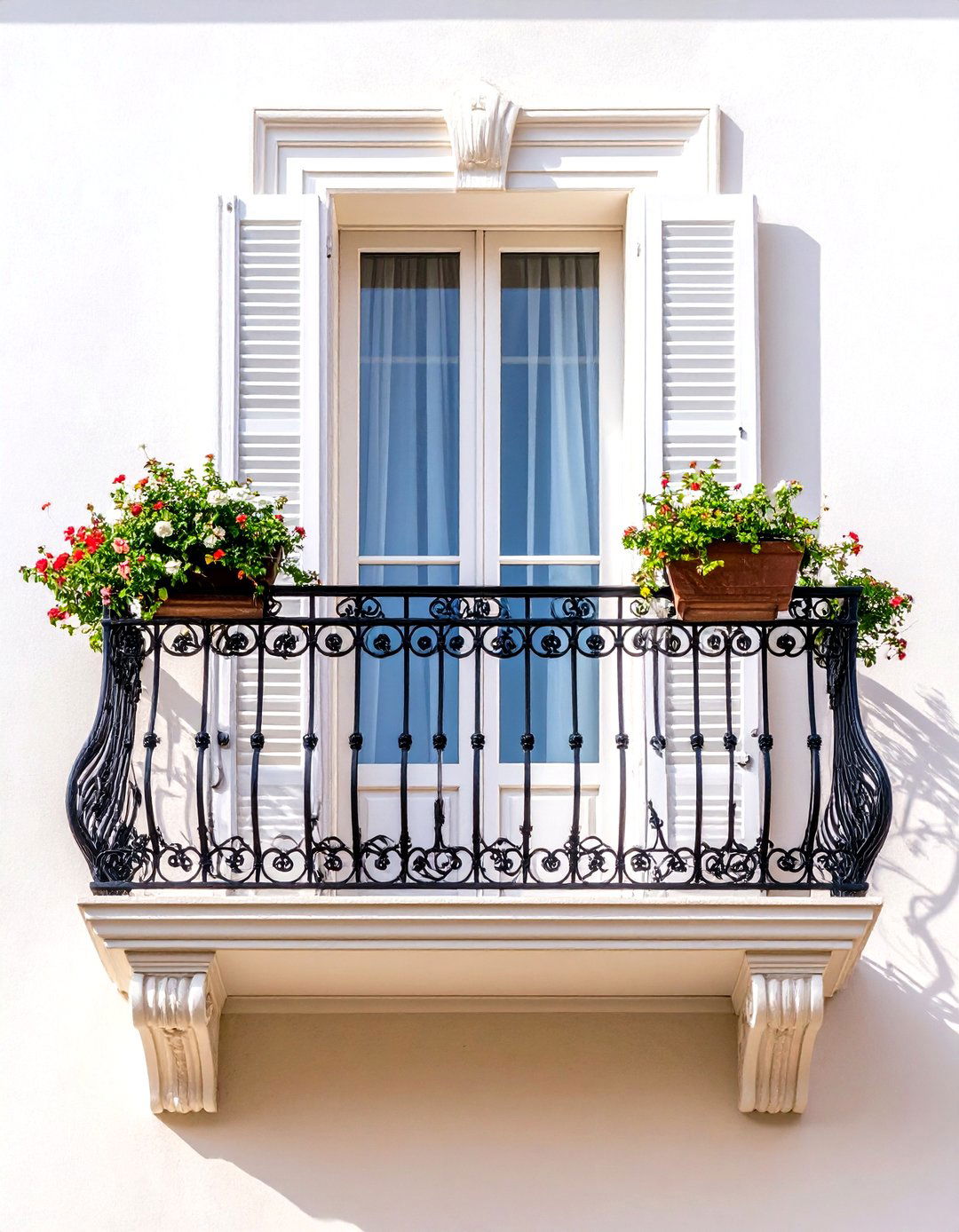
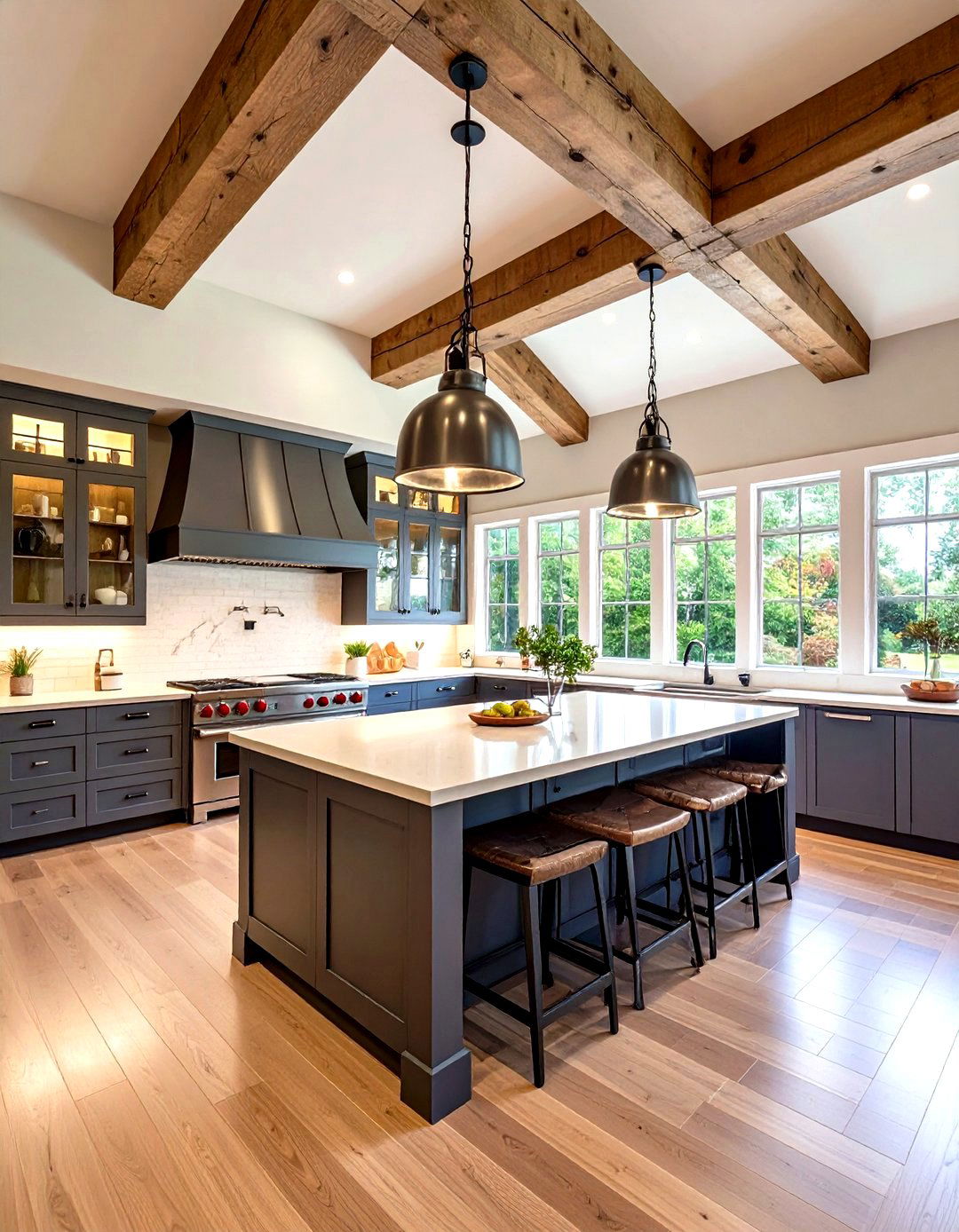
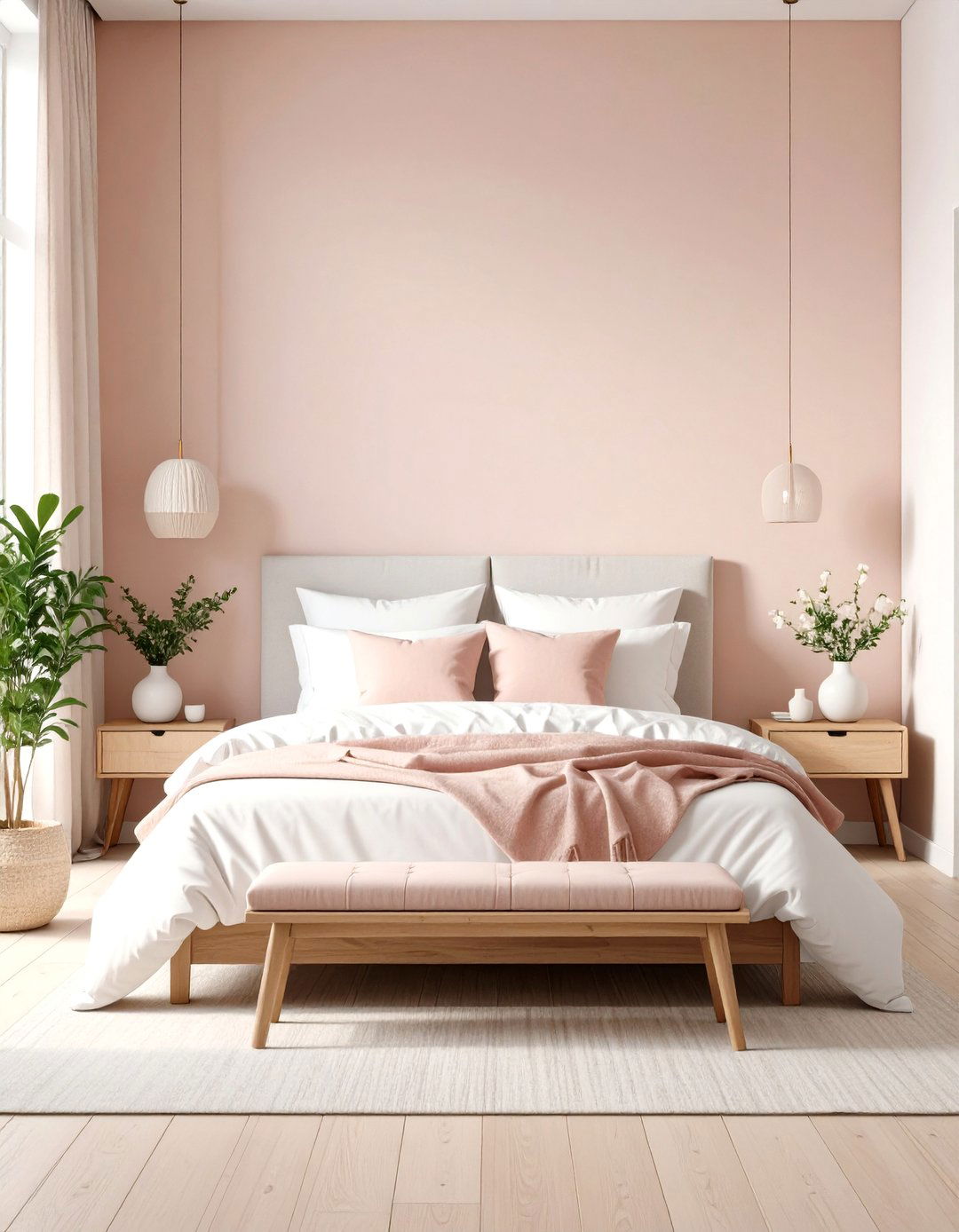
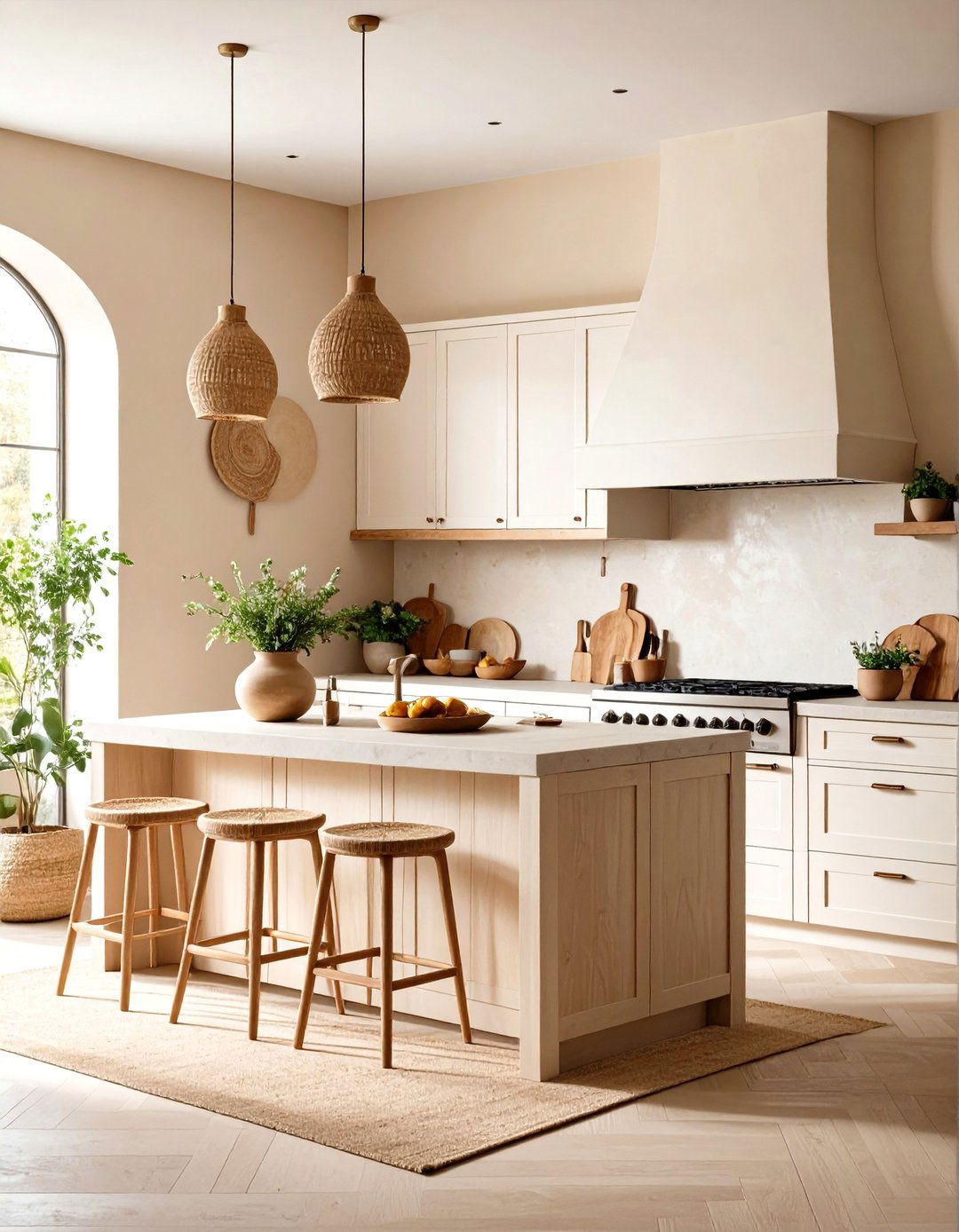

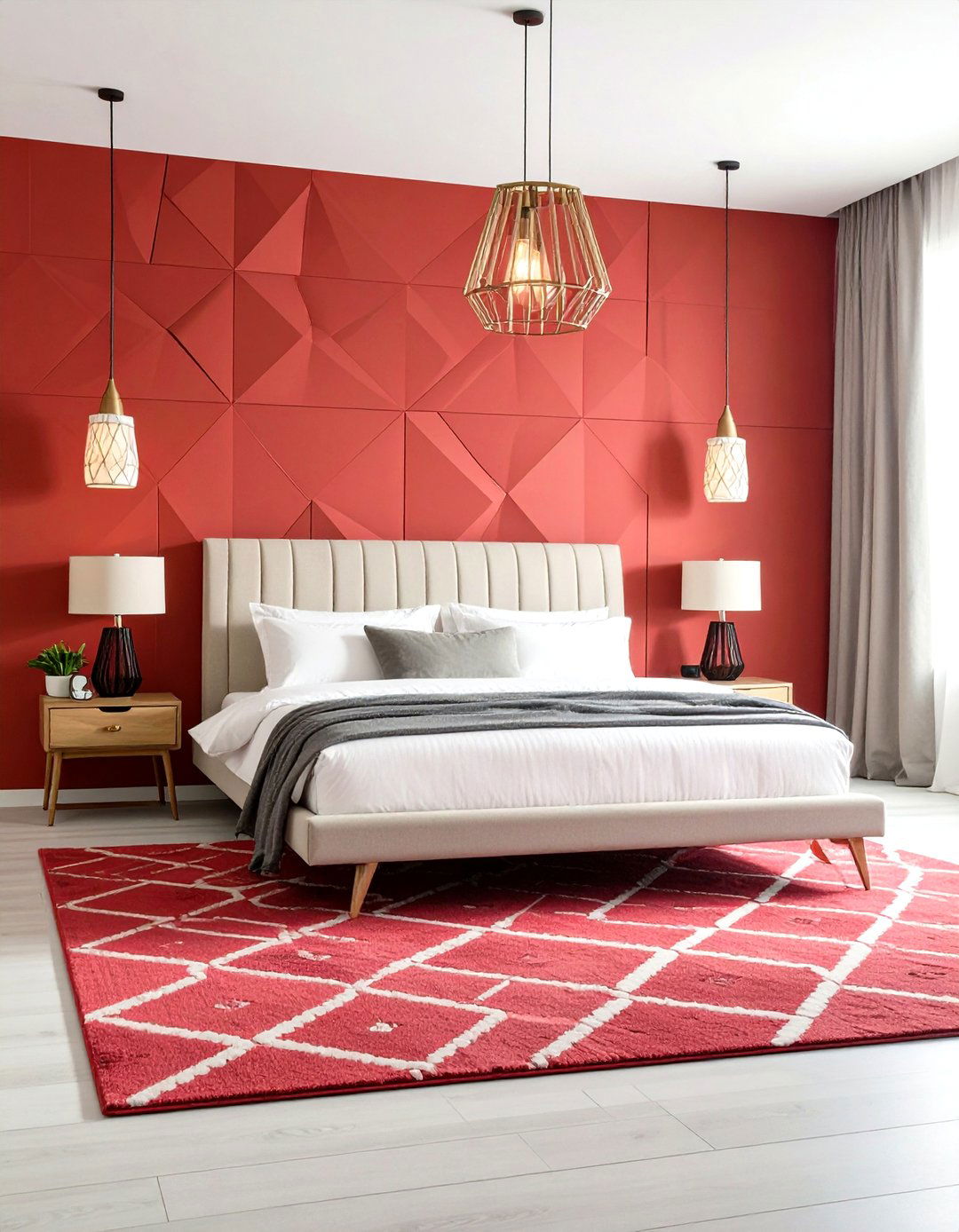
Leave a Reply